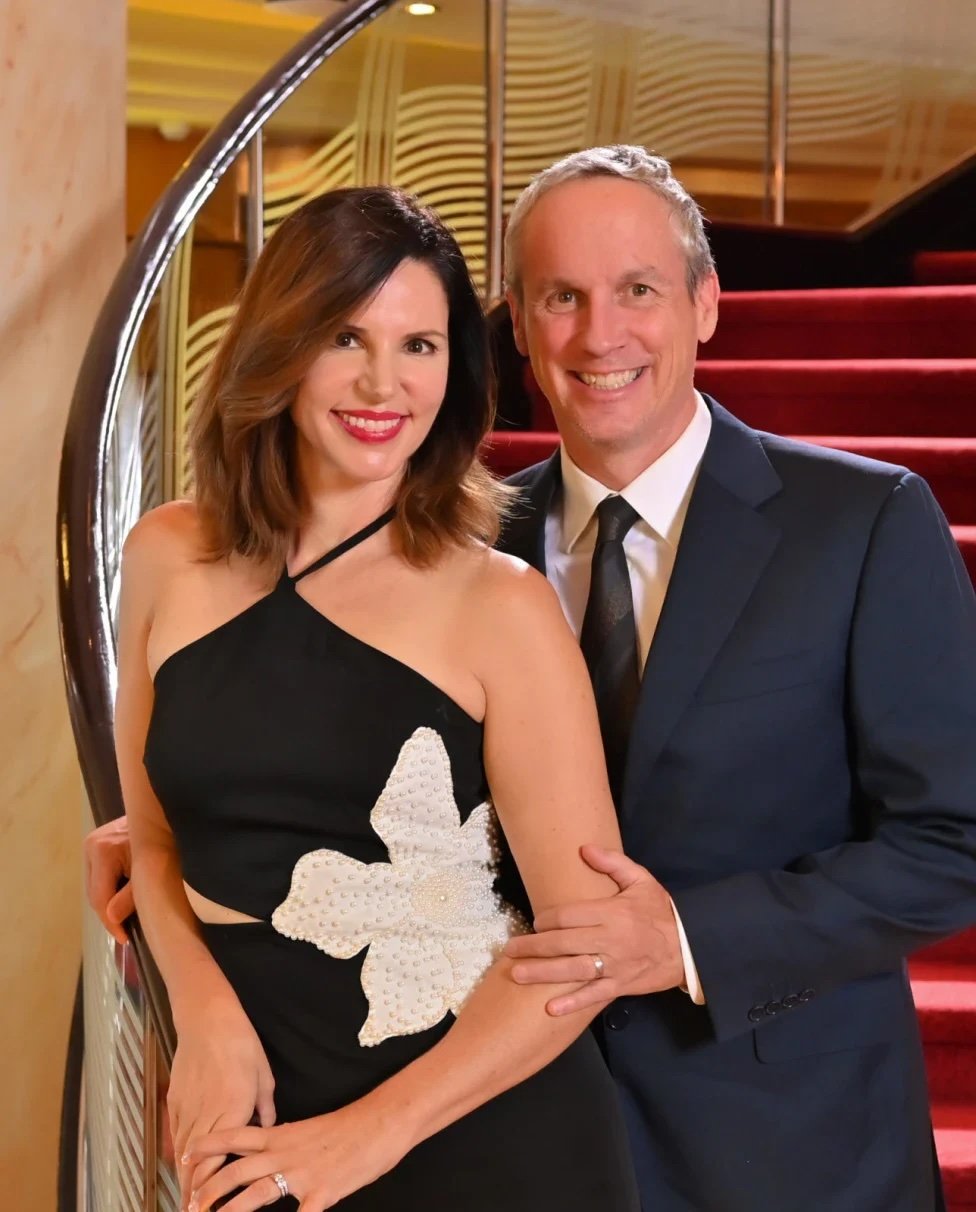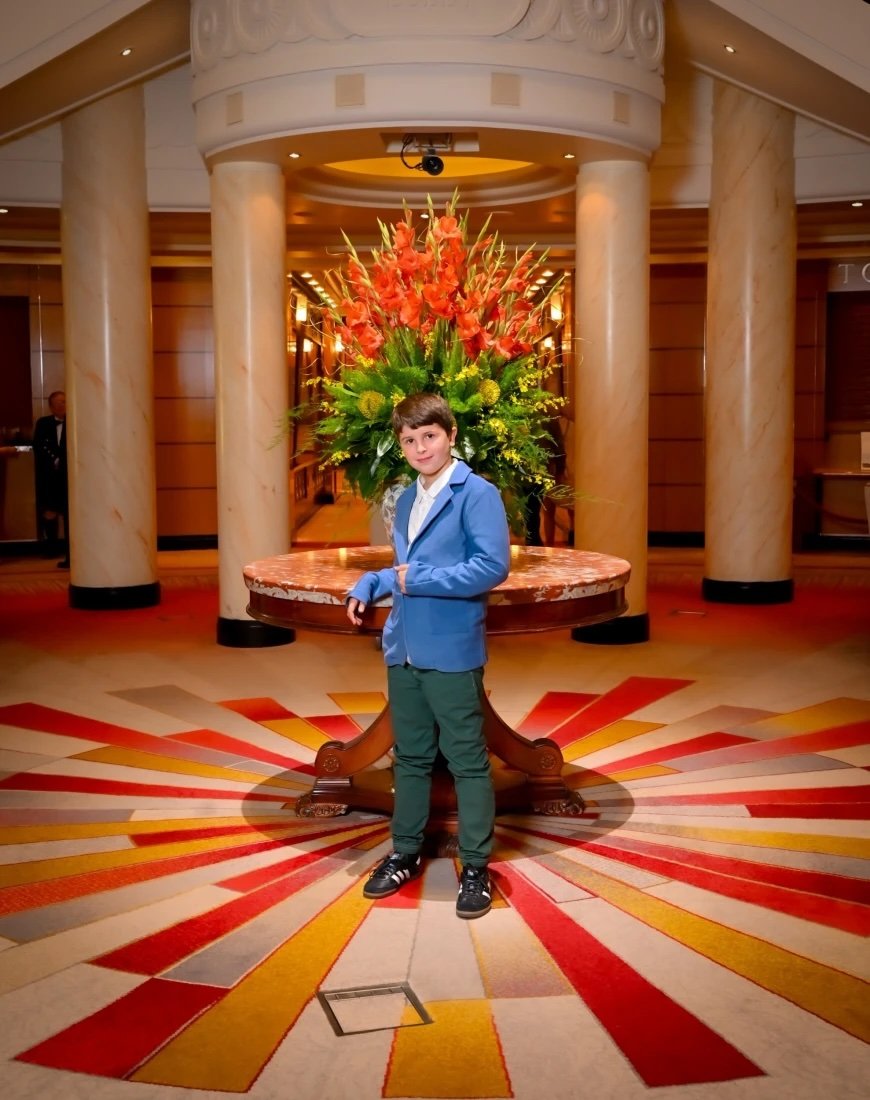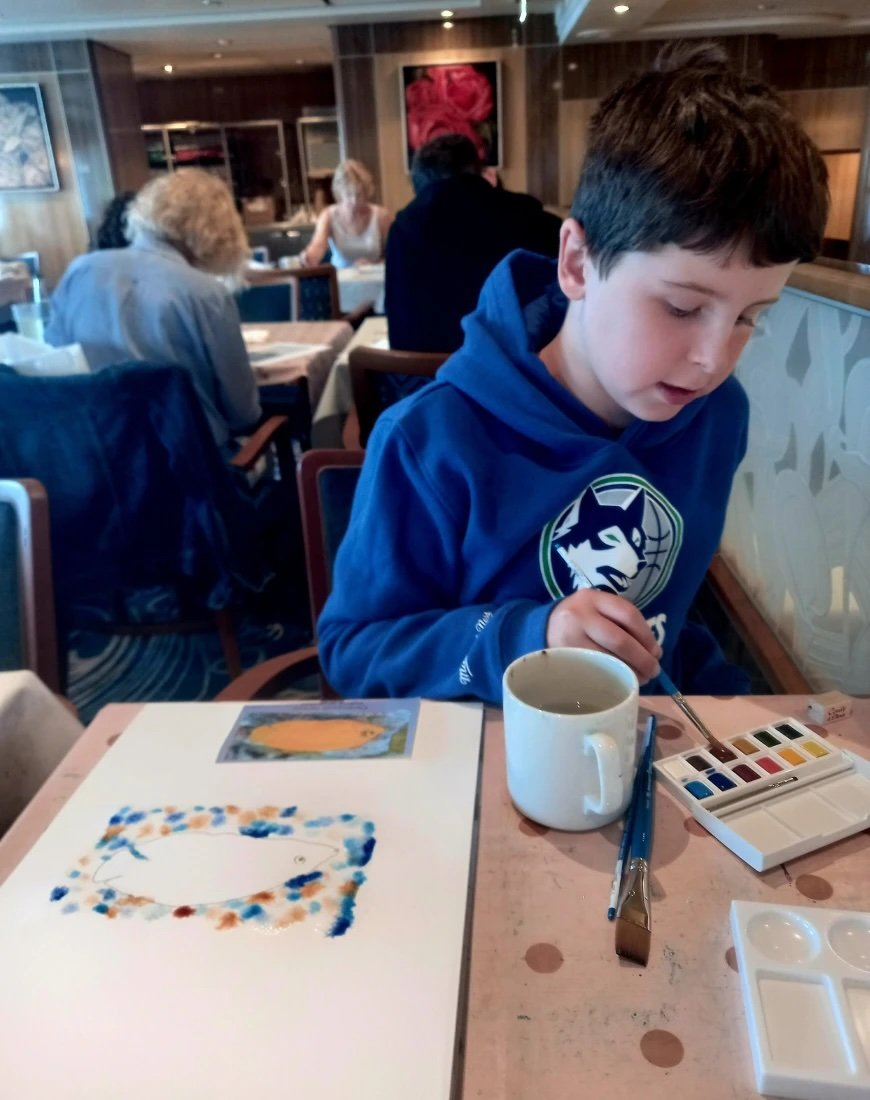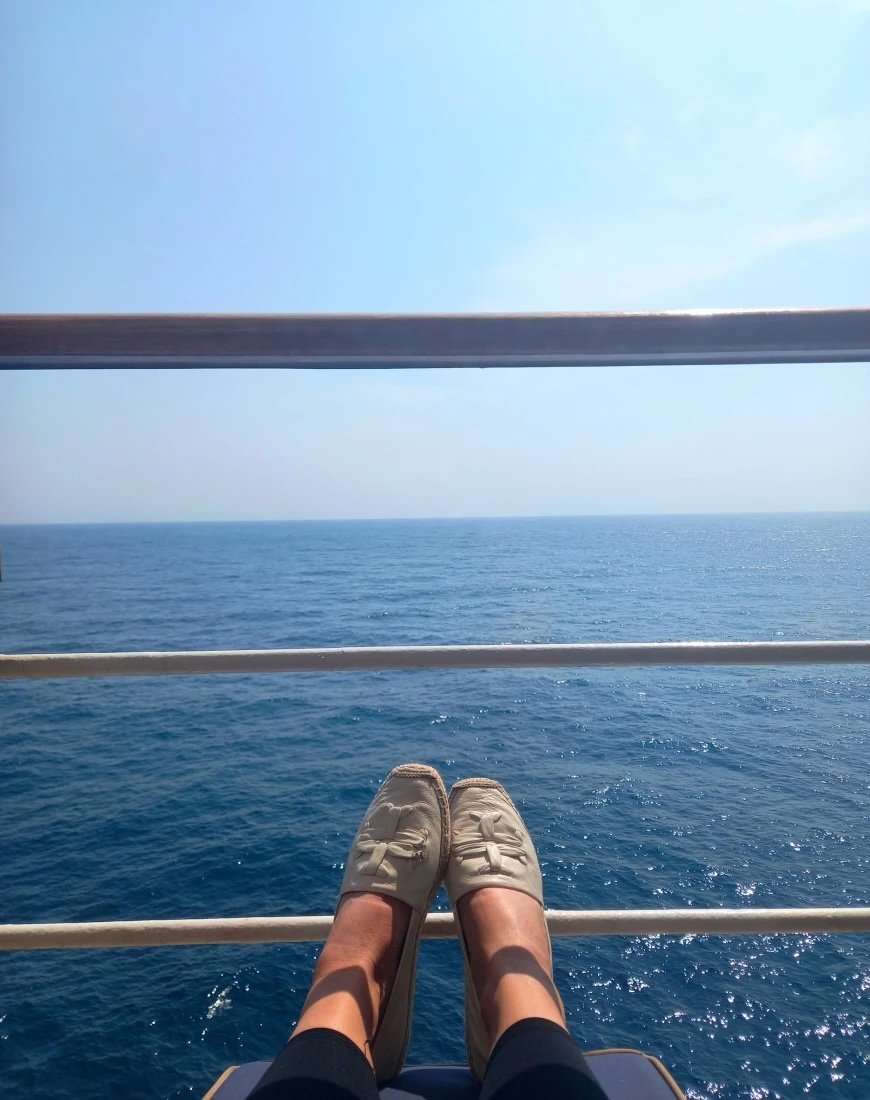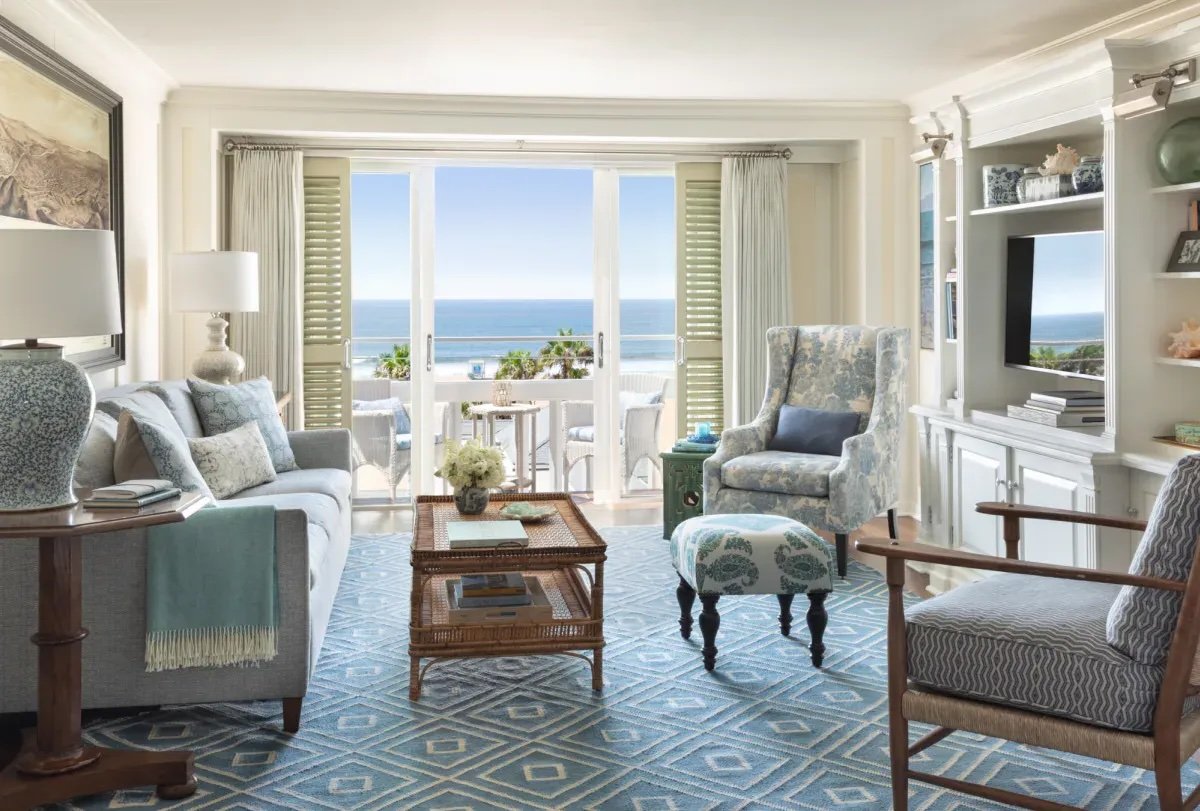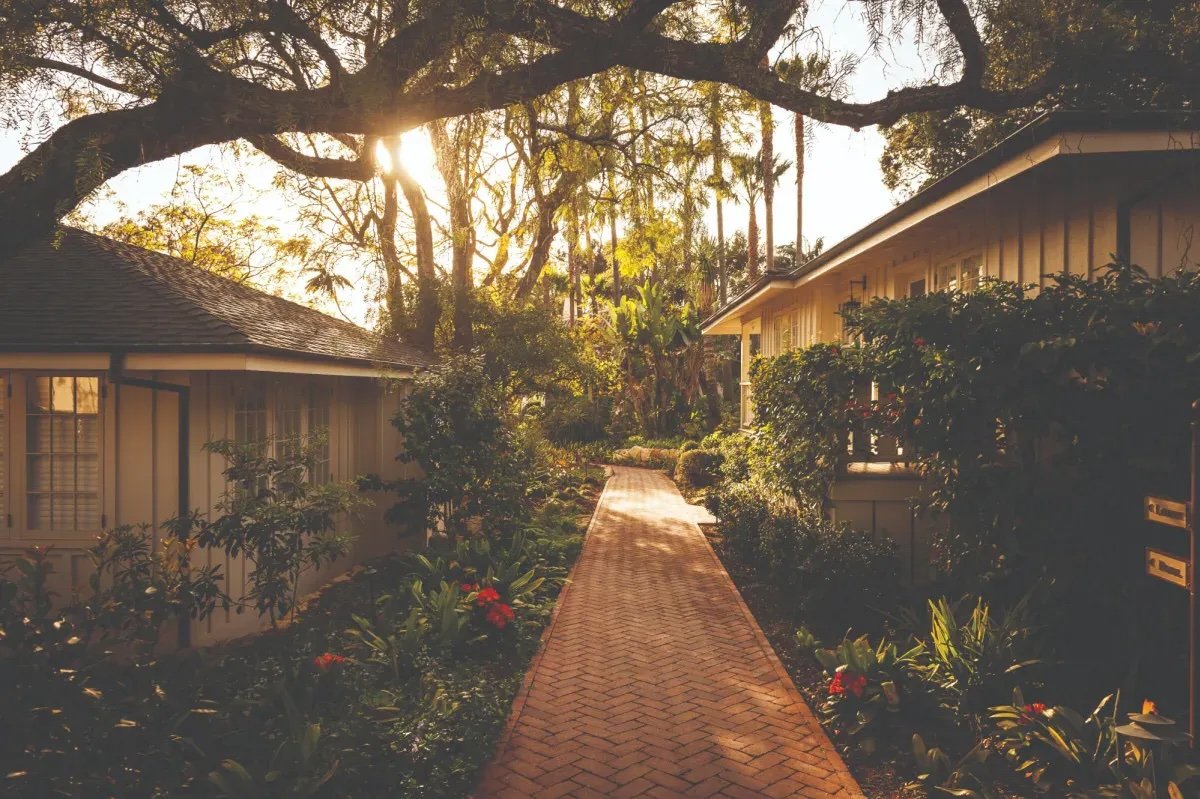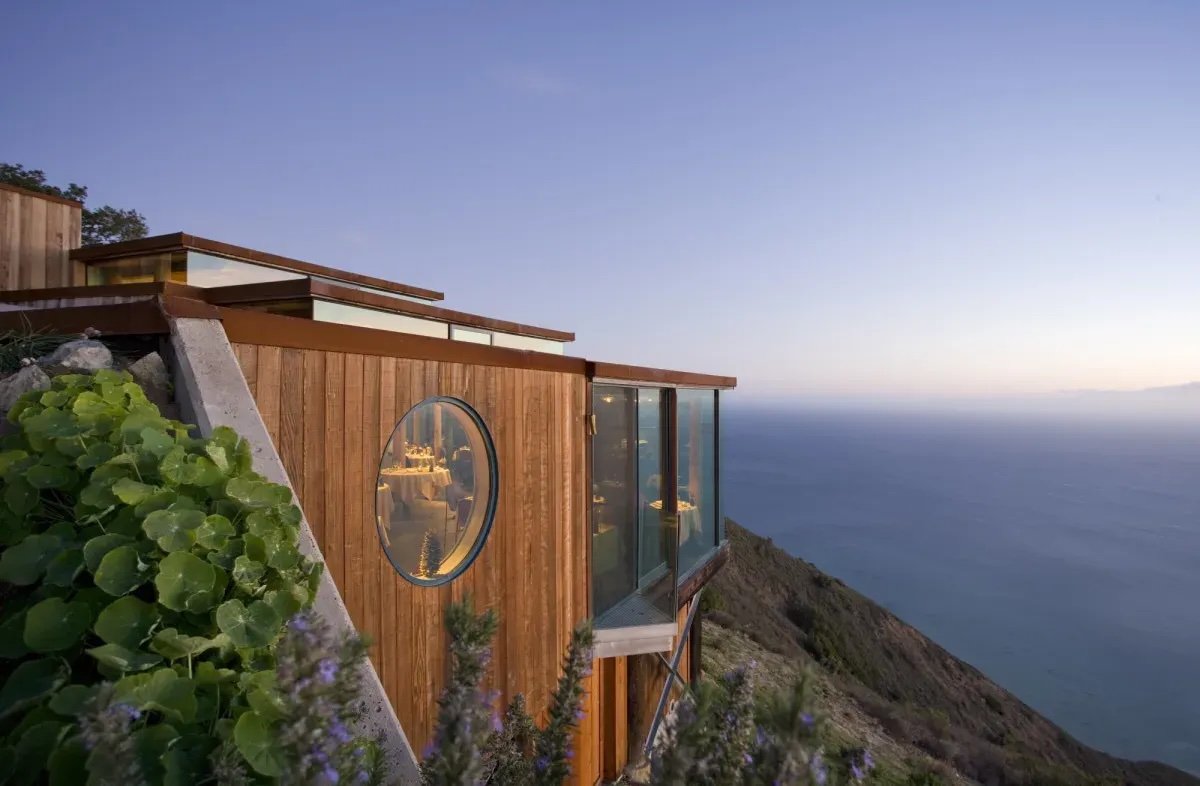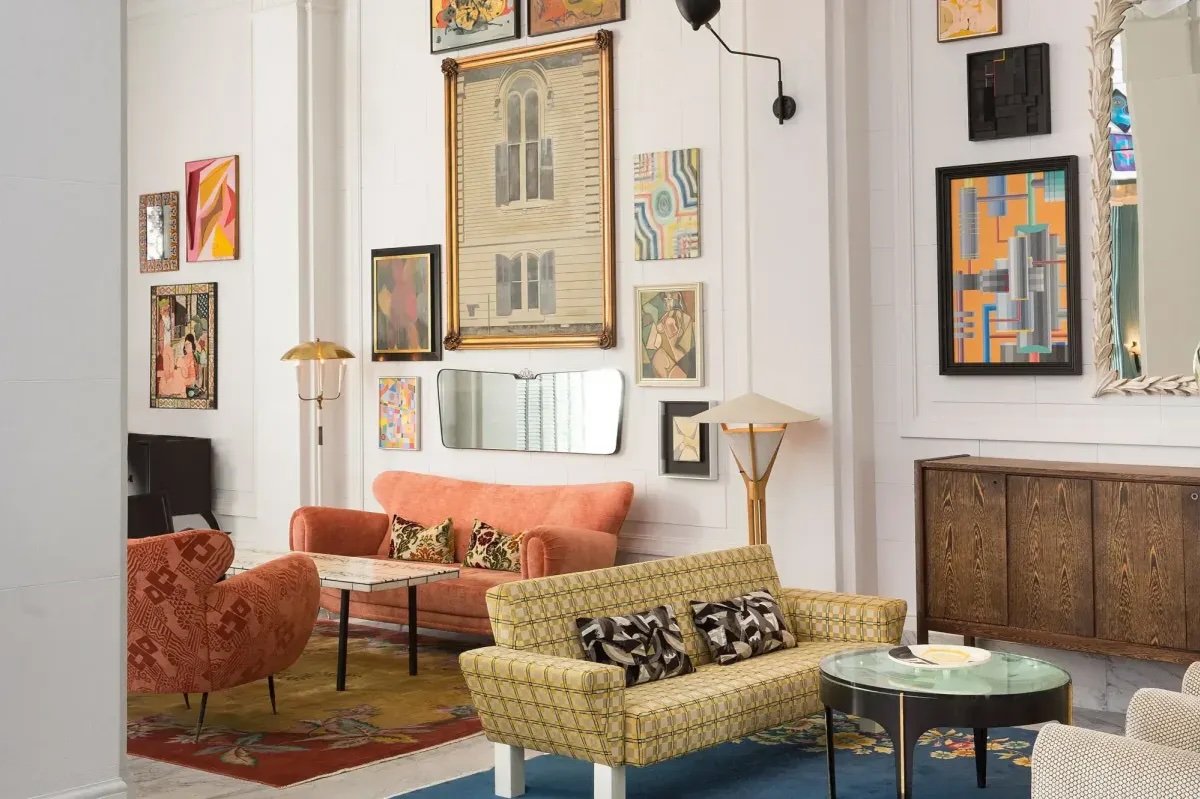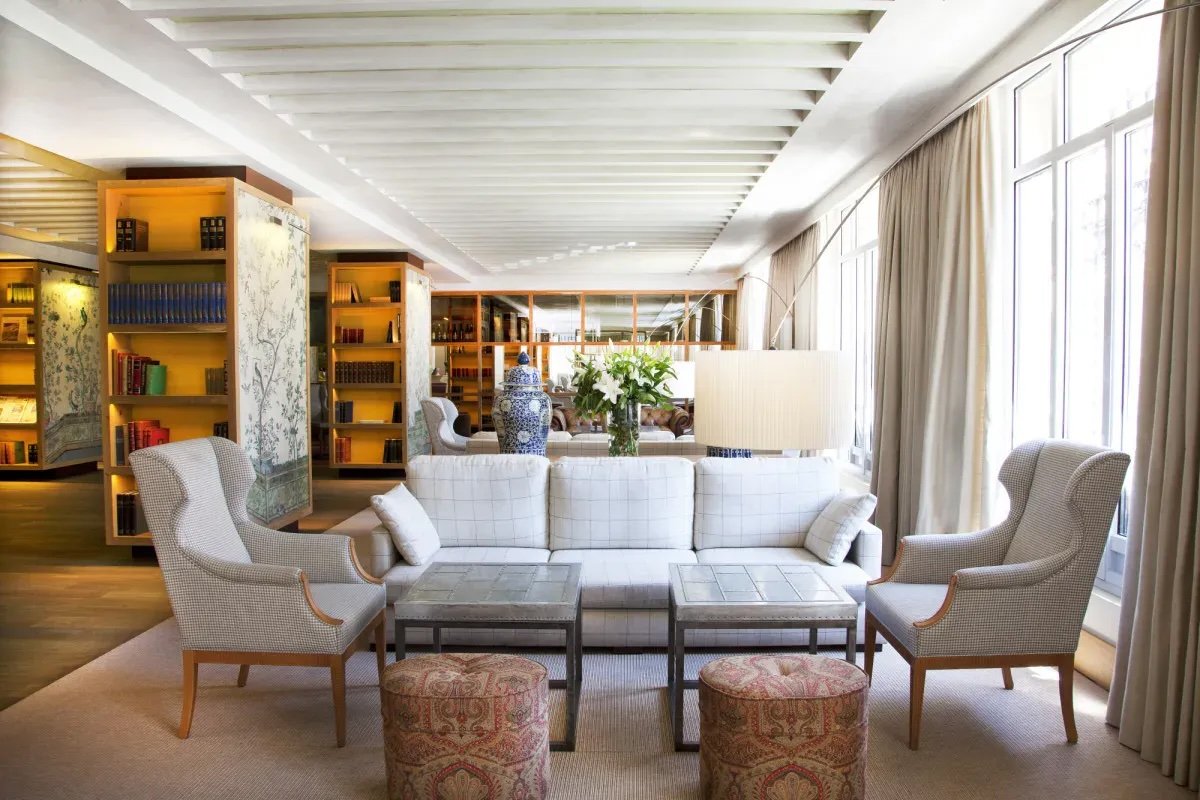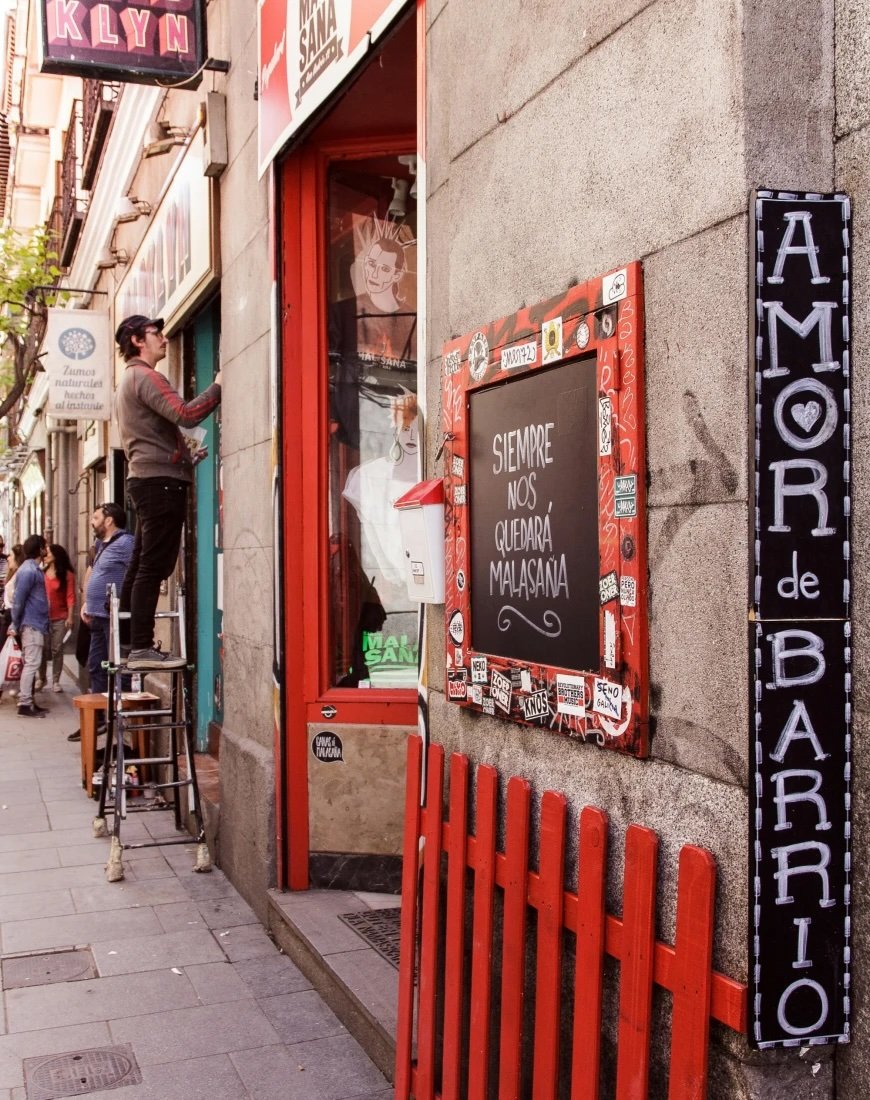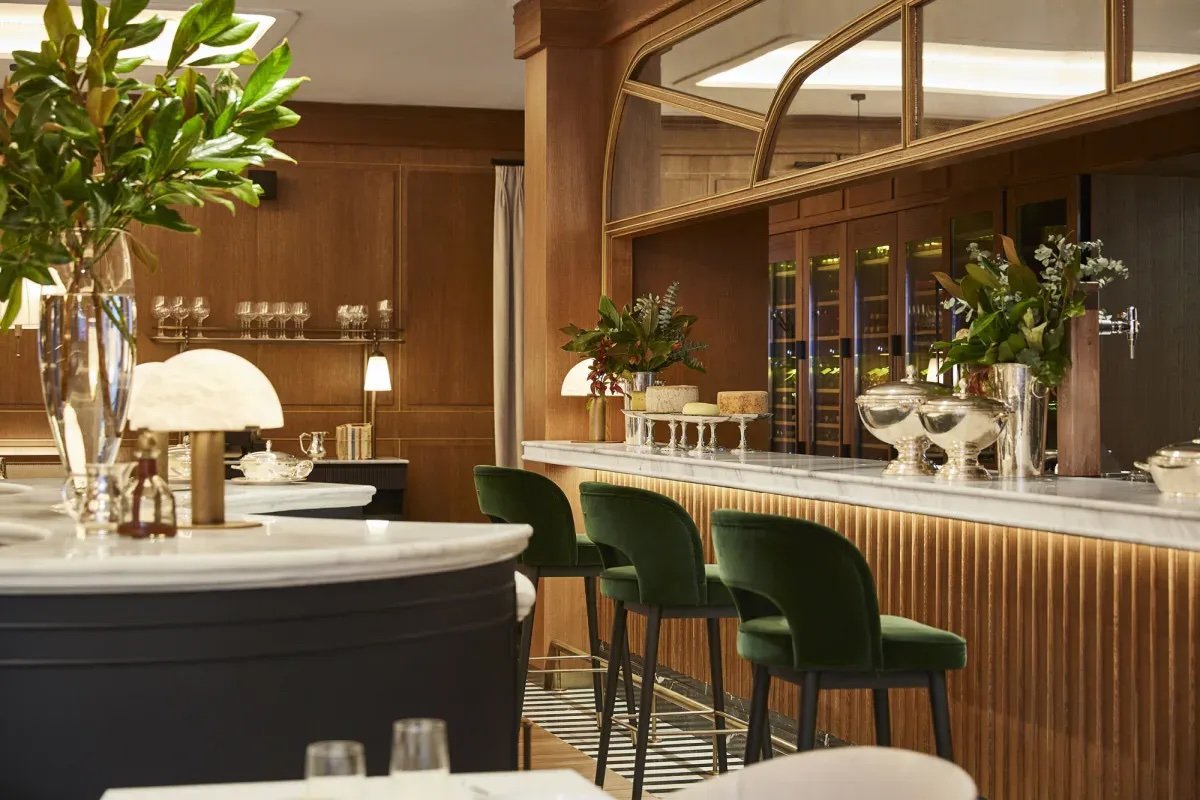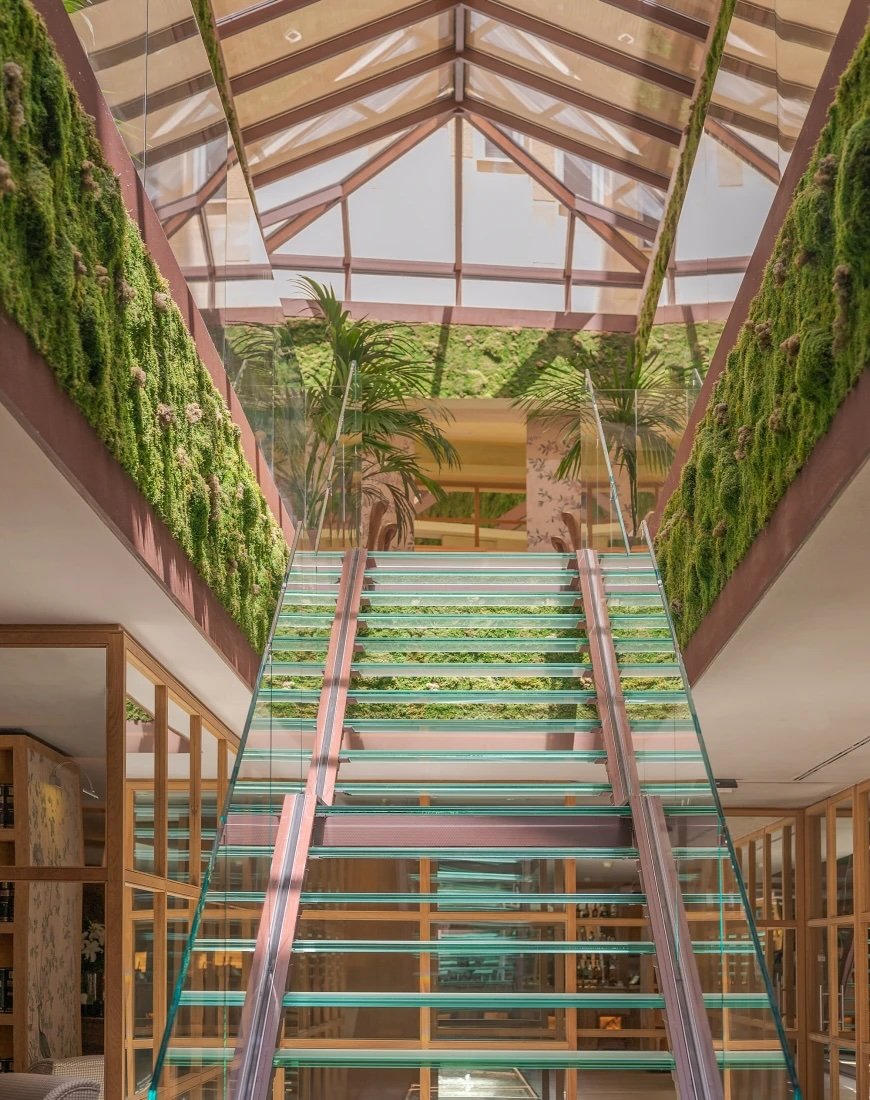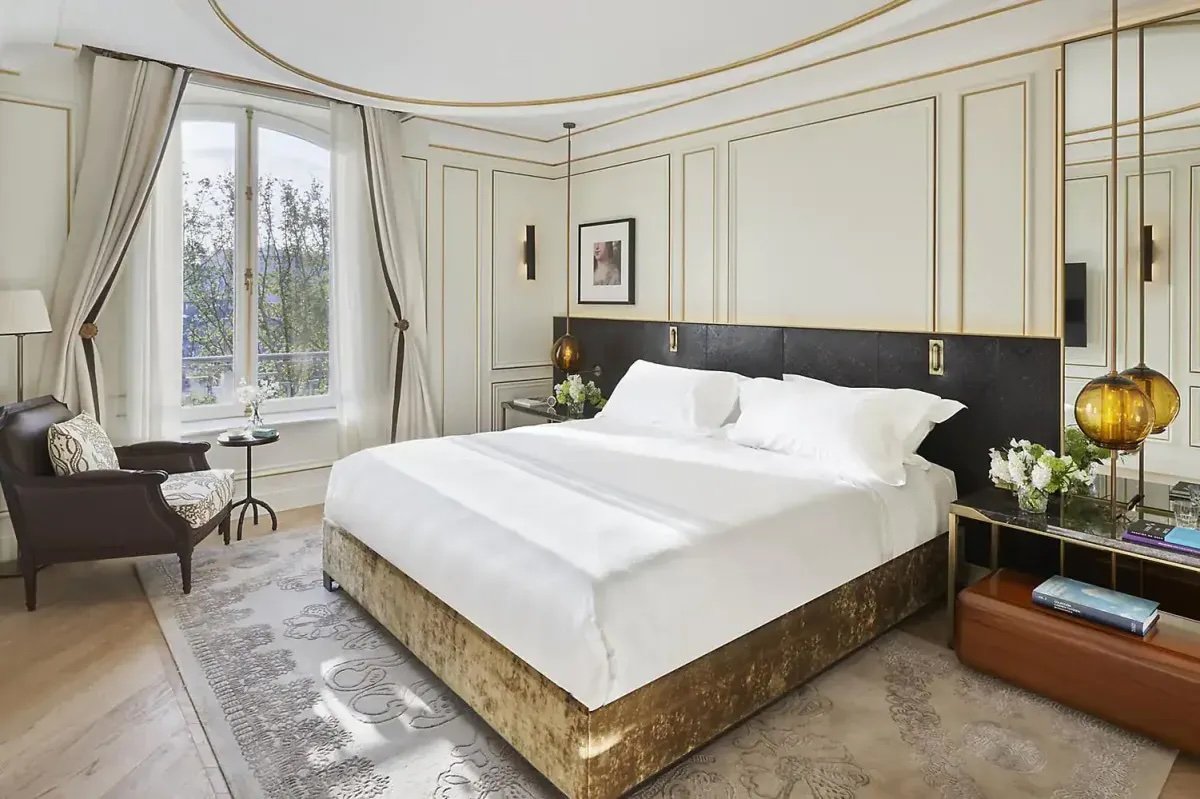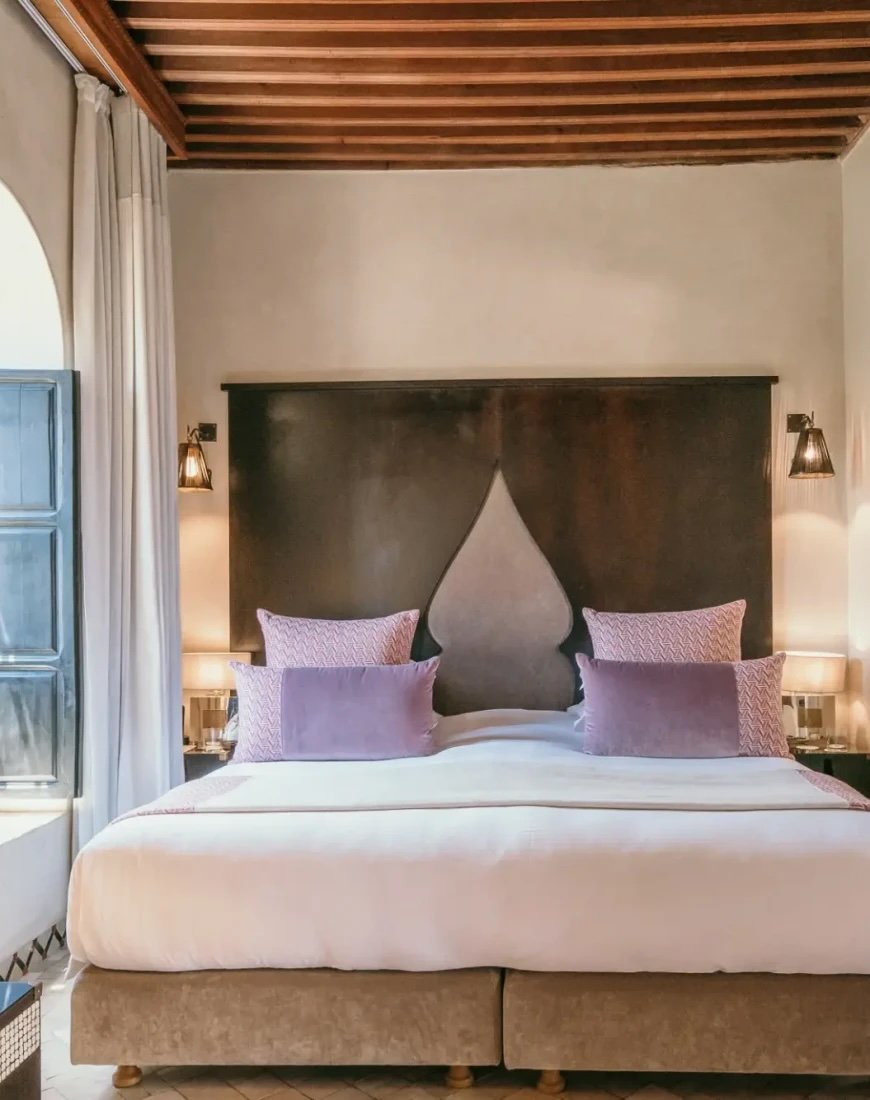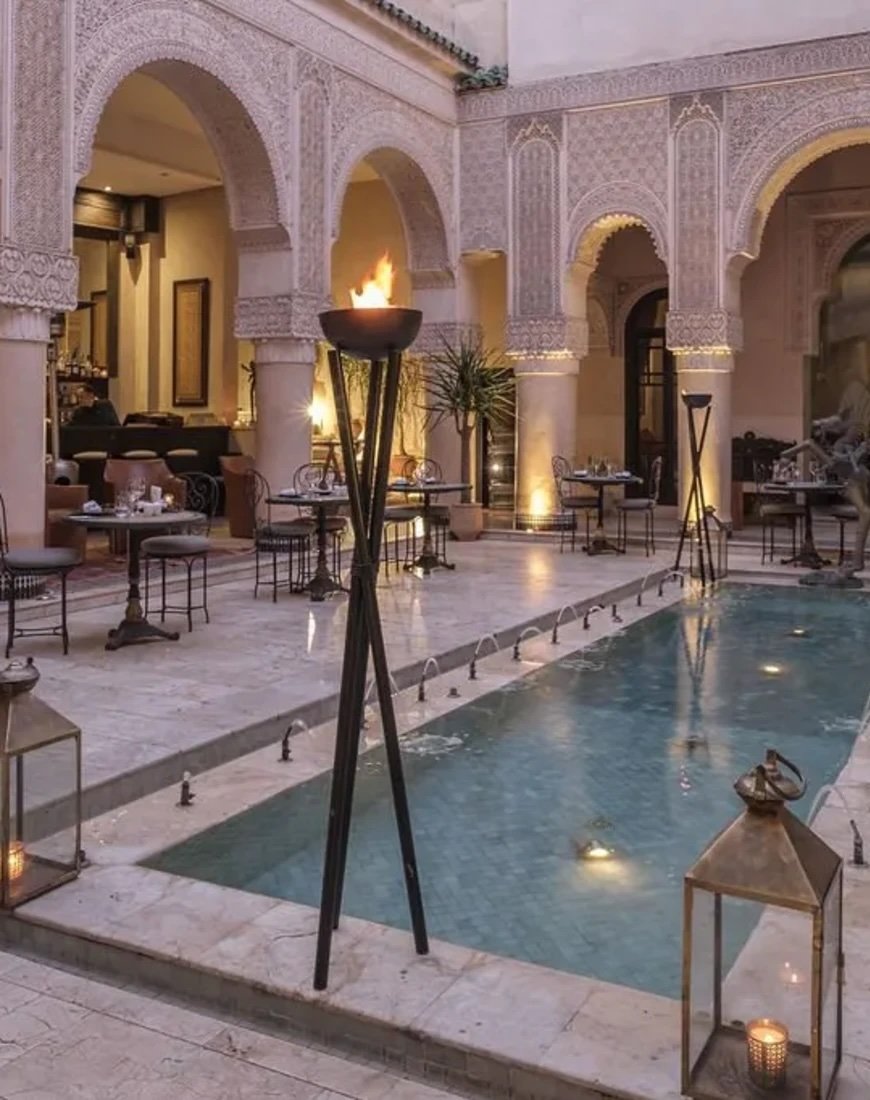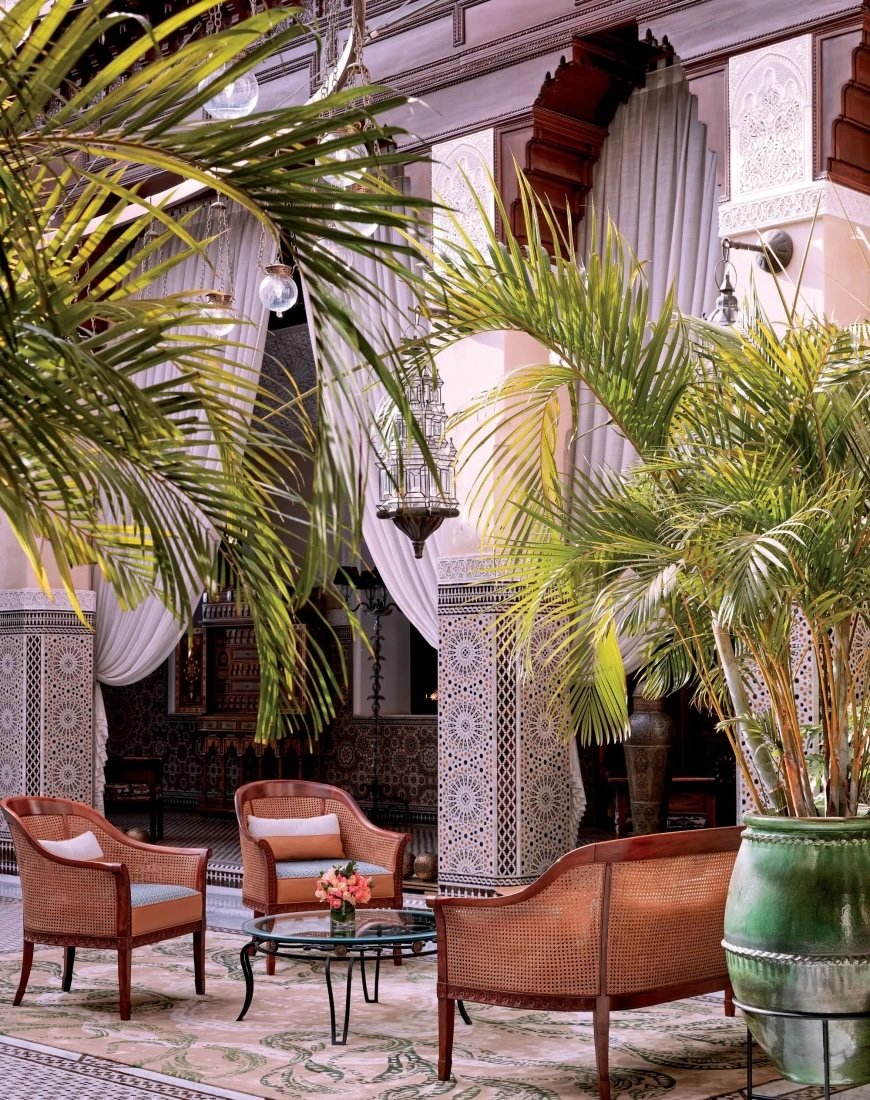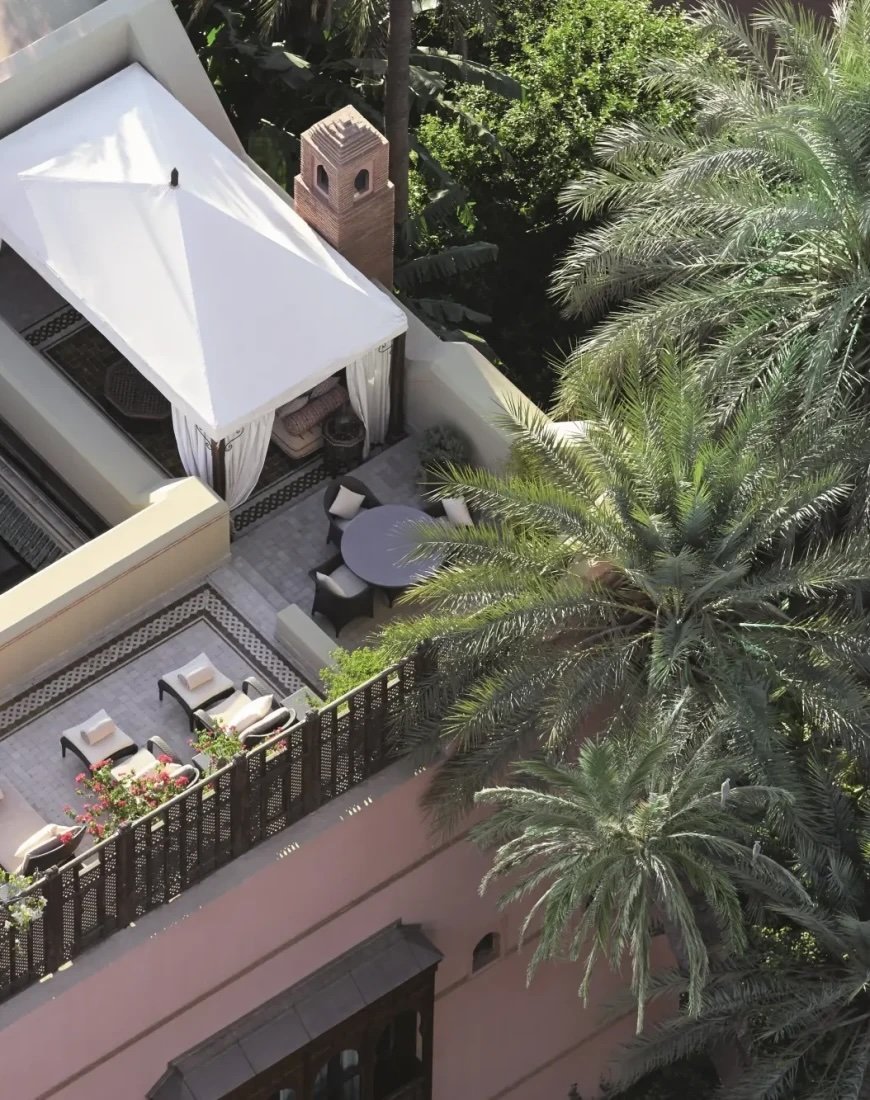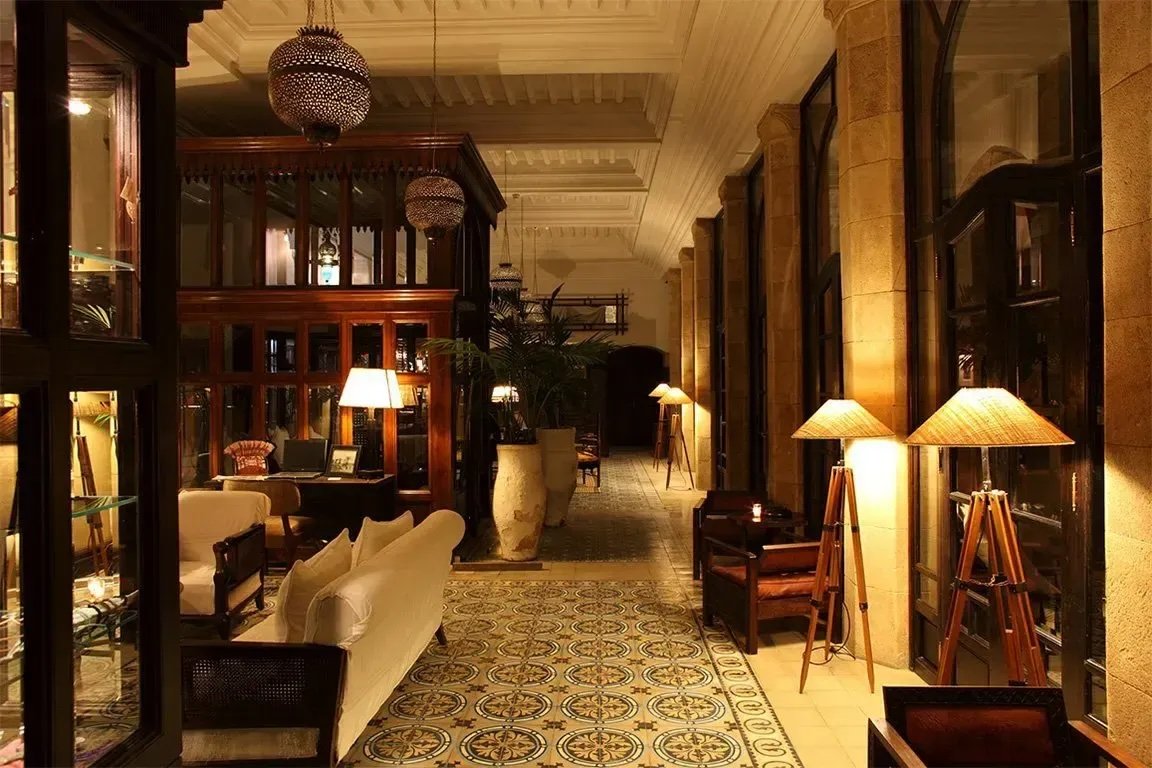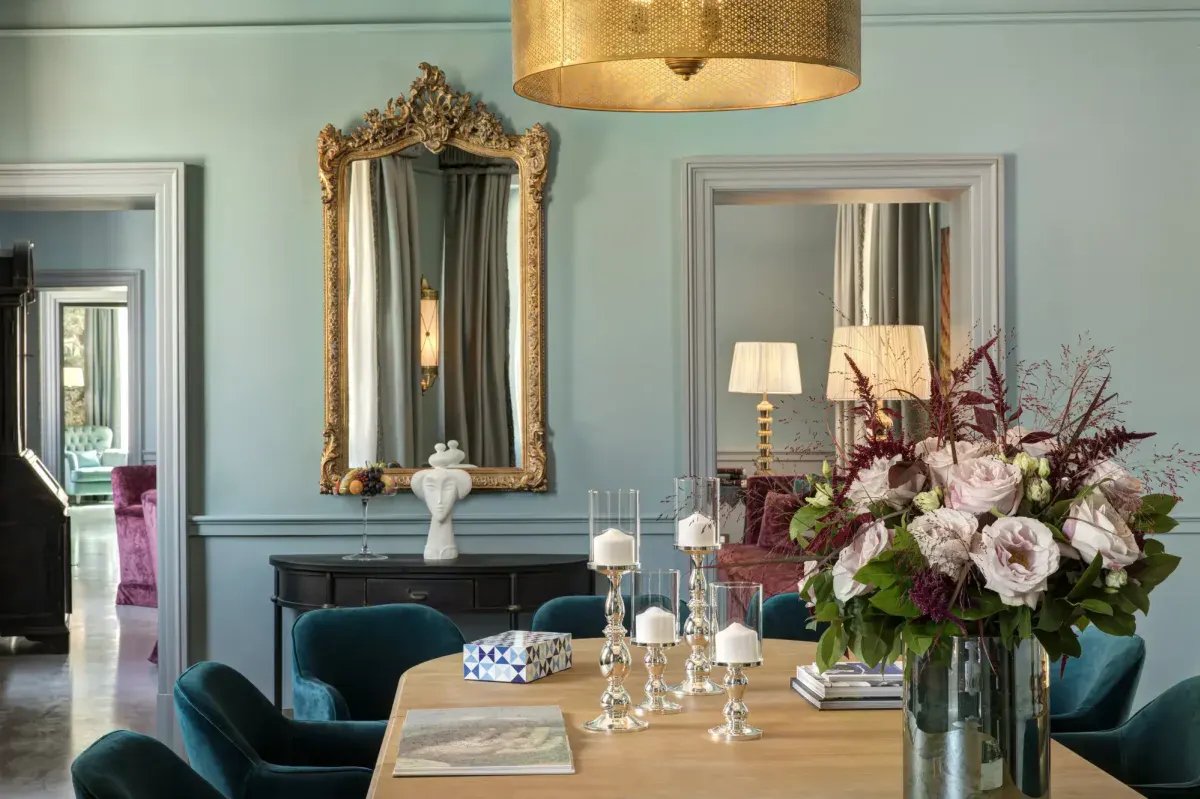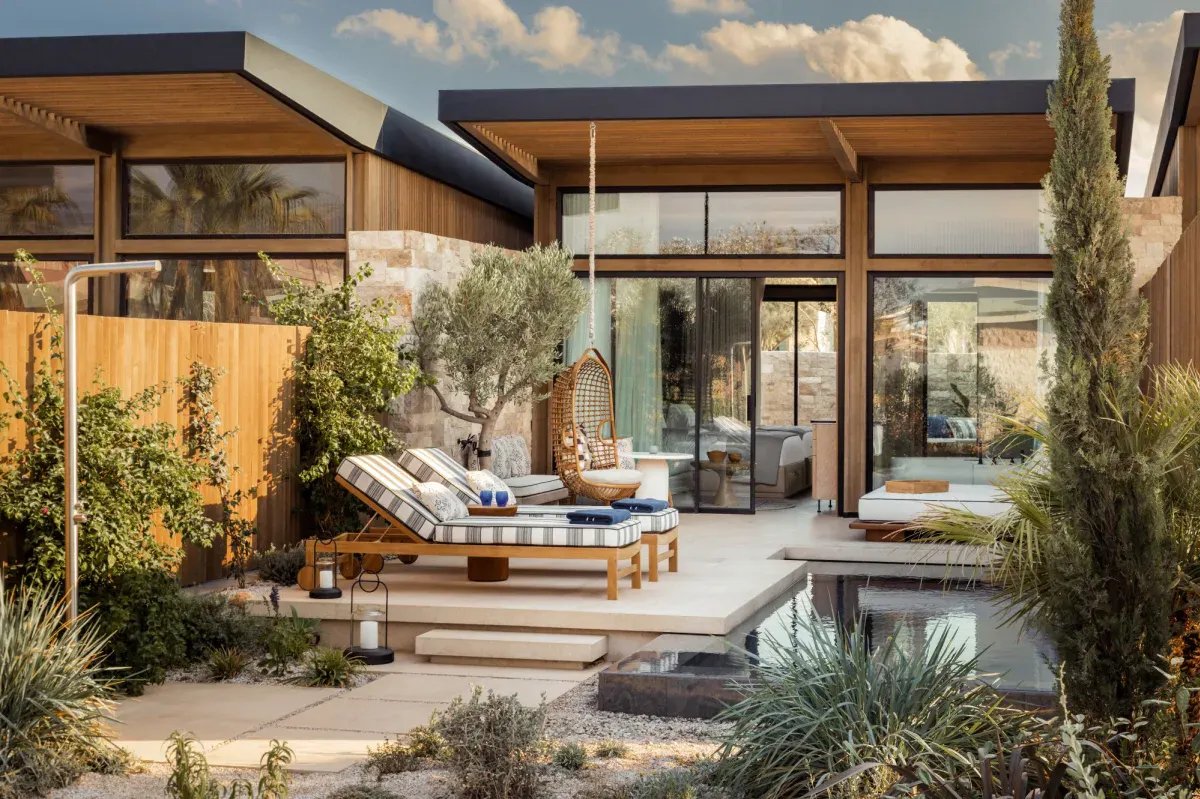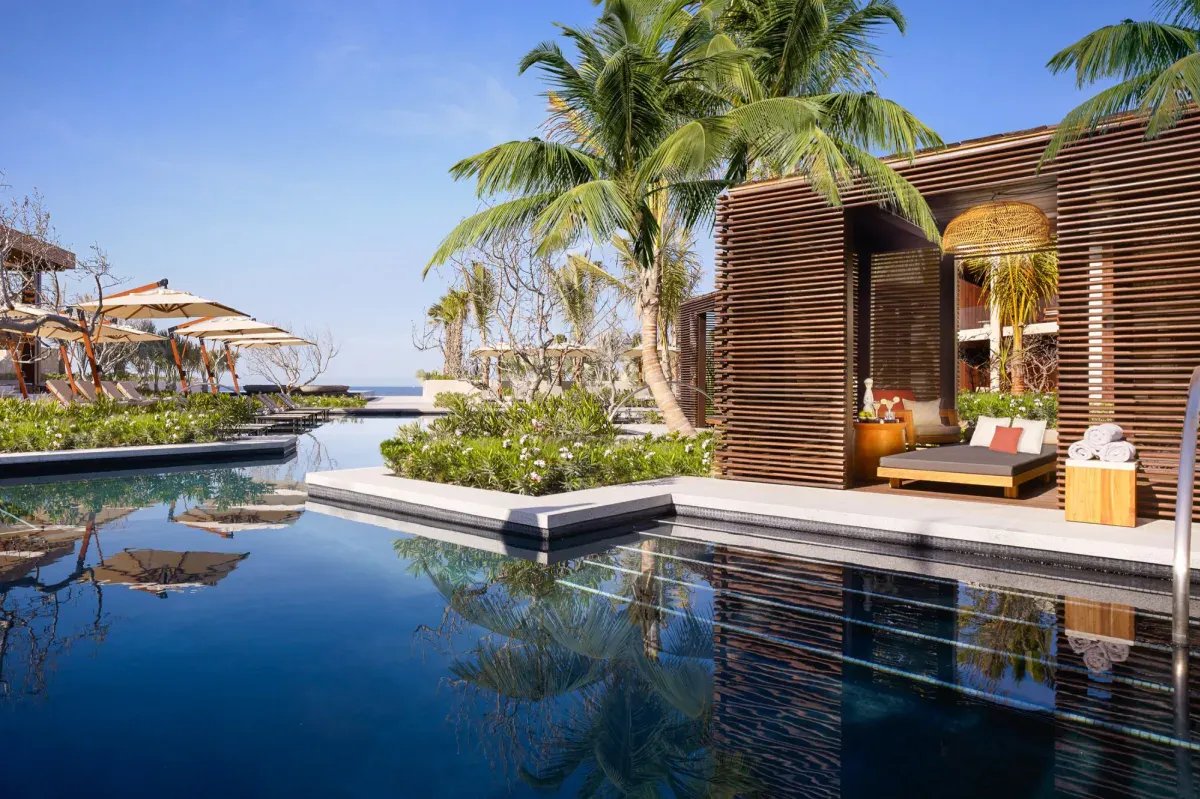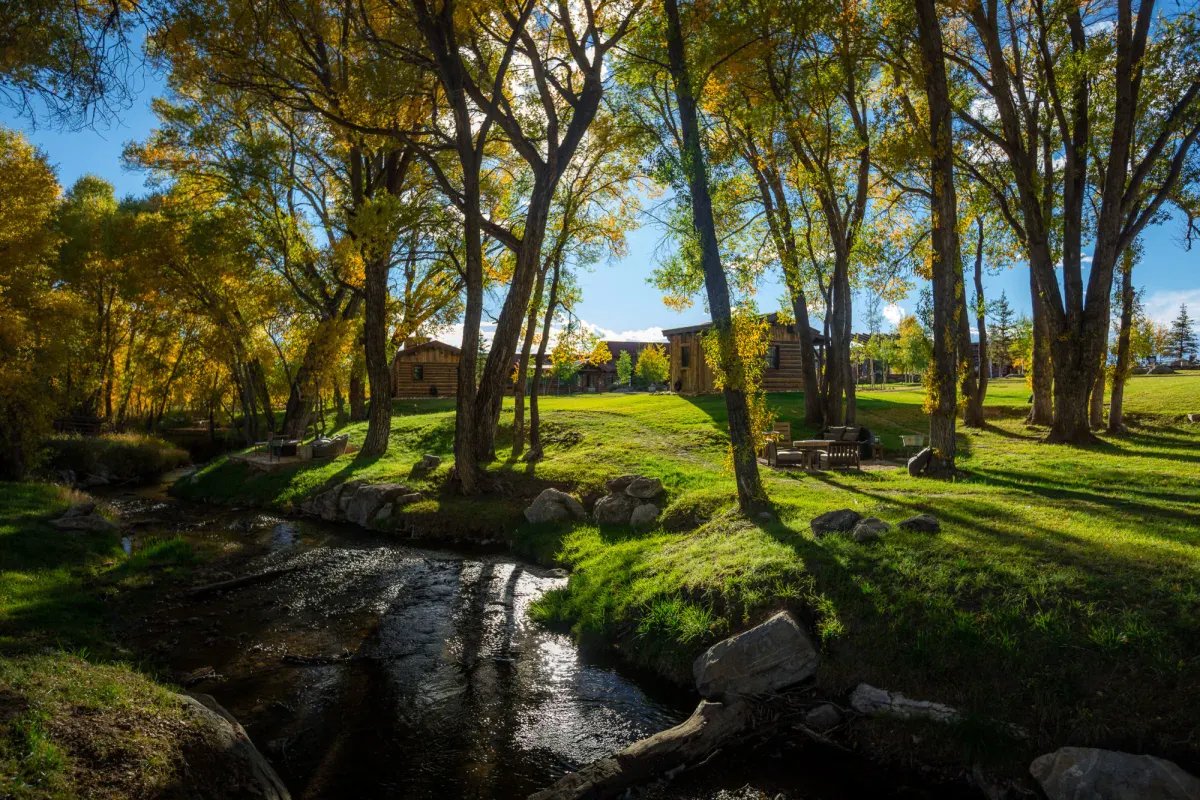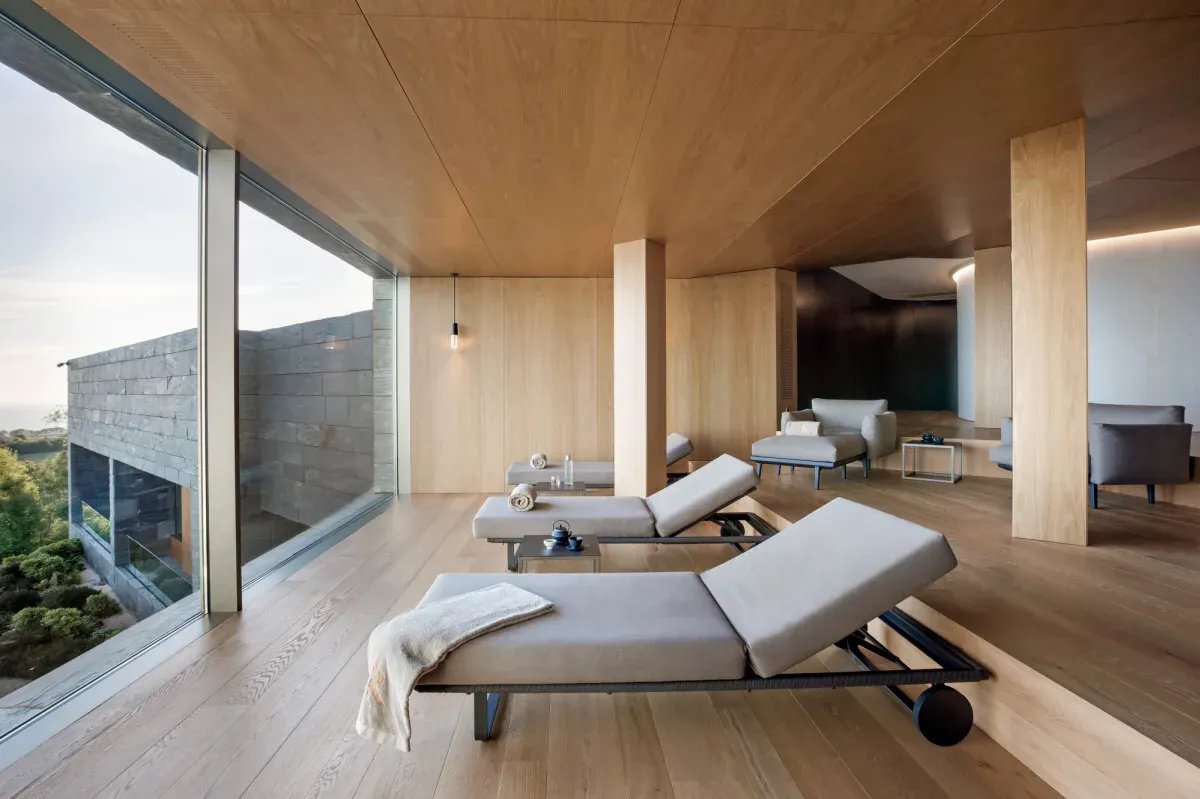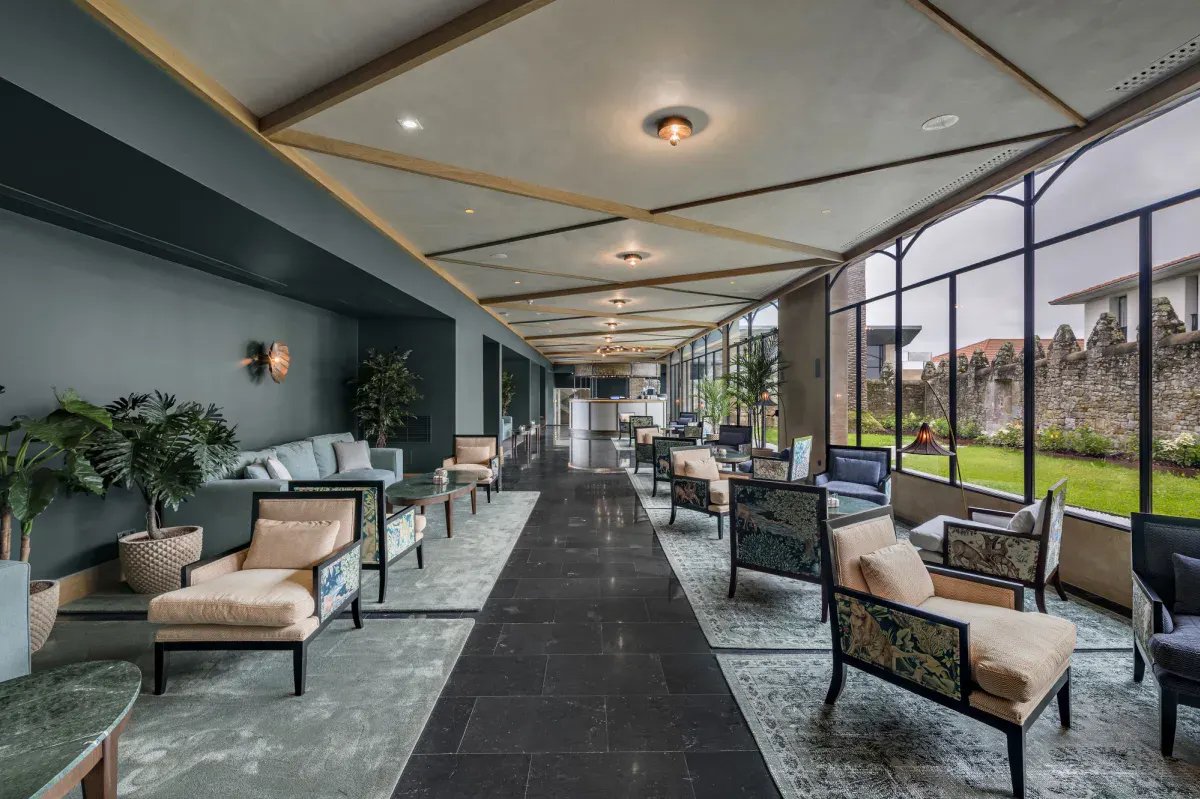Family Adventures at Sea: A Transatlantic Journey on the Queen Mary 2
Our family's transatlantic voyage aboard the Queen Mary 2 was an unforgettable experience of slow travel, where the ship itself became the destination. For seven days, we sailed across the Atlantic, enjoying timeless luxury — including afternoon tea at 3:30 pm, formal dinners and even ballroom dancing.
Our family's transatlantic voyage aboard the Queen Mary 2 was an unforgettable experience of slow travel, where the ship itself became the destination. For seven days, we sailed across the Atlantic, enjoying timeless luxury — including afternoon tea at 3:30 pm, formal dinners and even ballroom dancing. I bought my son his first sport jacket for the trip, and he looked like such a young gentleman in it! The elegance of the Queen Mary 2, from its grand library to lectures on maritime history, made the trip feel unusual and special. As a family, we embraced the journey together. We took watercolor painting classes and fencing lessons, played paddle tennis on the deck and watched for whales every afternoon from the hot tub. It was a beautifully slow, shared adventure that we really savored. For those seeking a different kind of getaway, this voyage across the Atlantic offers something rare — a chance to slow down, reconnect and immerse yourself in the simple elegance of life at sea.
The pinnacle of ocean cruising, where timeless elegance meets modern luxury on the high seas.
The Queen Mary 2 is known for its timeless luxury and impeccable service. Whether you're traveling as a couple or as a family, the boat offers something for everyone. For families with young children who might dread a long plane journey across the Atlantic, this crossing is a perfect alternative — combining adventure and elegance with plenty of activities to keep kids entertained. For us, it was the ideal way to slow down and enjoy time together as a family while experiencing the glamor of a bygone era.
Check-in:
Our check-in experience was remarkably smooth. From the moment we arrived at Brooklyn Port, it was clear that Cunard had mastered the art of efficient boarding. Despite the ship's size and the number of passengers, we were checked in and settled in our room within an hour, allowing us to begin our adventure without any hassle.
The room:
We opted for an inside cabin, thinking we’d spend most of our time exploring the ship, so it wouldn't matter if we didn't have a window. While the room was spacious and comfortable, with a fold-down bed for our son and two twin beds for us, we underestimated the importance of natural light. As the ship gradually adjusted its time zone by an hour each day, we had hoped to ease into the new time zone. But without natural light, it was difficult to stay on track. When we do this crossing again, we’ll definitely choose a room with a window or balcony. Aside from that, the room itself was perfect — immaculately clean and surprisingly roomy for a ship cabin. Our dedicated cleaners, one from India and one from the Philippines, were amazing. They were so friendly and kept our area absolutely spotless.
The boat:
The Queen Mary 2 is nothing short of a stunner. This ship exudes elegance, with stylish lounges, colorful art deco paintings and a modern art gallery that surprised us with how cool and interesting its collection was. Fresh flower arrangements greeted us in the Grand Lobby, where a pianist played in the afternoons, and every corner of the ship was beautifully maintained. There wasn’t a worn carpet or shabby seat covering in sight. Everything was elegant, yet comfortable. It's also filled with wonderful nooks and crannies, and one of my favorites was the library. The library is absolutely beautiful, with small clusters of leather chairs perfect for curling up with a book. And there are plenty of books to choose from — 8,000, in fact! We loved how the library wound around, giving us the feeling of exploring as we wandered through it. The spiral staircase inside the library is also really impressive and really adds to the sense of grandeur.
Food:
The food was consistently excellent. At dinner, we had a dedicated table, waiter, sommelier and dining time. It was lovely to stroll into the room and greet our waiter, Ryan, and to have our sommelier know us by name and remember what kind of wine we liked. Every dinner felt like fine dining, and we enjoyed the meals tremendously. The menu was different every day, too. We never actually made it to the more formal breakfast, because we were never all awake by the time it closed. Instead, we would make our way to the all-day buffet on the seventh floor. This was our go-to place for breakfast and lunch, and it was a casual and tasty way to eat these two meals. High tea was served every day at 3:30 on the dot by waiters with white gloves, offering tea alongside delectable little cakes, scones and sandwiches. The experience of being at high tea felt genteel and English, and we loved it. This was our son’s favorite "meal" of the day!
Onboard experiences:
With so many activities to choose from, we had to think carefully about how to spend our time. We spent some time lounging in deck chairs, reading and hopping between the pool and hot tub. But on other days, we were more ambitious. One of my favorite experiences was taking a watercolor class with my son, led by the ship’s resident artist. There was a fencing class available, too, which I don't think is very common on cruise ships. Meanwhile, my husband took part in the near-daily paddle tennis tournaments, even winning one with his partner!
The evening entertainment was another highlight. We saw a variety of shows, from comedians and musical performances to dance shows. The entertainment was consistently good, but one of the most unique aspects of our trip was that it was the Queen Mary 2’s 400th transatlantic crossing. To mark the occasion, there were special maritime lectures, including a talk by the man who designed the ship! One of my favorites was a session on the history of zeppelin travel, which included news that zeppelins might be making a comeback as a mode of transportation. Although these experts were brought on specifically for this special crossing, there is always an Insights Series featuring different expert lectures on all sorts of topics. We loved this aspect of the trip!
Spa:
The Queen Mary 2 boasts an incredible 20,000-square-foot spa. I visited the exclusive indoor thermal suite pool on deck seven, which requires an additional fee but was well worth it. The spa also includes steam rooms, saunas and a relaxation lounge. I also got an Elemis facial, which was an indulgent experience, delivered by a skilled aesthetician from South Africa. After spending two blissful hours there, I left feeling completely relaxed. The staff throughout the ship, including the spa, hail from all over the world, adding to the cosmopolitan atmosphere onboard. While the spa is luxurious and fabulous, the fitness room is on the lowest level of the boat and feels a bit like... a basement. That said, the fitness classes themselves were great and still very enjoyable.
Kids Club:
On the sixth floor, there is a wonderful dedicated Kids Club. It's large and filled with natural light, and has different zones inside it. They have an area with computers for kids to play video games. For my son, who tends to be quite restricted on his video game access, this was a real treat. They also have a huge selection of board games, activities like face paintings, and movie nights. It was a great place to hang out. We had to book it in advance, but it was never full, and we could do this at the last minute. We got into the habit of taking our son down to the Kids Club for a few hours after dinner. Meanwhile, my husband and I would go to one of the swanky lounges and enjoy a quiet cocktail by ourselves. It worked out great for all of us!
A quiet escape:
As much as we loved the planned activities, some of the best moments were the quieter ones. Our family spent a lot of time in the hot tub, chatting with fellow passengers and simply watching the horizon. It was here that we met some of the most well-traveled people, exchanging stories and learning about their adventures. One lovely woman told us about her time working for Queen Elizabeth and how she met her husband while he was singing karaoke in Florida. We also befriended a couple from Tennessee who live near country stars like Billy Ray Cyrus and Wynonna Judd — they shared how down-to-earth their famous neighbors are. A pair of financiers from Connecticut, seasoned travelers who frequently take back-to-back Cunard cruises, filled us in on their favorite routes around the world. One afternoon, while soaking in the hot tub and chatting with these fascinating people, we were all lucky enough to spot a pod of whales — a magical moment we won’t soon forget.
The vibe:
The Queen Mary 2 has a reputation for being a more formal boat, and this is true. It's also one of the reasons people choose the Queen Mary 2 over many other companies. The experience of being on board evokes a bygone era of elegance and glamor, where people dressed for dinner. It barely exists anymore, but it does on the Queen Mary. We didn't find this to be stuffy, though. Everyone was wonderfully friendly, including the other guests. But it did elevate the experience and added to the sense of charm and occasion that we felt with the entire crossing. For us, the ship provided the perfect balance of adventure, elegance and relaxation.
Conclusion:
The Queen Mary 2 provided our family with an unforgettable experience of luxury, adventure, and connection. It was the perfect way to cross the Atlantic, offering elegance and sophistication without sacrificing fun and relaxation. Whether you’re looking for an alternative to a long plane ride or simply want to experience the grandeur of a classic ocean liner, Cunard’s Queen Mary 2 is a fantastic choice for families, couples and travelers seeking something special. We can’t wait to sail again!
Need to know
Lastly, Cunard now uses Starlink for internet access, and we found the charge to be very reasonable with excellent connectivity throughout the trip. You’ll use two online platforms during your journey: "MyCunard" for pre-boarding information and planning, and "MyVoyage" once on board for daily schedules and ship information.
This trip can either start in Southampton, England or in Brooklyn, New York. We have wonderful hotels in both locations. On the New York side, it’s worth spending a few days and catching a show on Broadway. Our family stayed at the historic Iroquois Hotel in the Theater District and saw Little Shop of Horrors the night before we sailed — it was such a fun way to start the trip! On the Southampton side, we visited nearby Stonehenge and stayed a few nights in Bristol at the elegant Marriott Hotel before flying back.
As a certified Commodore with Cunard — the highest level of training they offer — and I’m here to help you book your Cunard voyage and ensure you receive extra perks along the way. Let me take care of the details so you can experience the elegance and tradition of a Cunard transatlantic crossing on the Queen Mary 2!
Cunard’s Queen Mary 2 is the only true transatlantic ocean liner, not a typical cruise ship. It’s built to withstand rough seas, offering a distinctive and robust experience. While you won’t feel much movement on board, it’s still a good idea to bring seasickness medicine, just in case the seas get really rough.
If you’re concerned about jet lag, consider booking a room with windows or a balcony to help adjust naturally as the ship changes time zones. We traveled in late August and had great weather, but as we moved into the North Atlantic, it got cooler — so pack sweaters and warmer clothes to be prepared for different conditions.
Formal nights are a highlight of the journey. If you want to take part in the elegant evening events, be sure to bring formalwear. In addition to formal nights, there are two gala nights on every transatlantic crossing. Ours were "black and white" and "1920s," and people went all out — many men wore tuxedos, though my husband wore a suit and fit in just fine. If needed, tuxedos can be rented on board.
For families, if you plan to use the Kids Club, make sure to reserve a spot. It’s easy to do, even at the last minute. There are also many unique onboard activities like fencing lessons, lectures and daily high tea that add to the traditional charm of the ship.
This trip report is part of our ongoing series on travel to Brooklyn, New York. In need of further inspiration? Check out Jane Hermstedt’s guide, A Local’s Guide to a Perfect Summer Week in Patagonia's Lake District.
California Coast: The Ultimate Road Trip
A perfect road trip requires great views and even better stops along the way. Driving down the California coast checks both boxes; it’s difficult to think of a better road trip route in the U.S.
Image courtesy of 1 Hotel West Hollywood
A perfect road trip requires great views and even better stops along the way. Driving down the California coast checks both boxes; it’s difficult to think of a better road trip route in the U.S. There are many ways to go about this, but the following route is a tried-and-true favorite.
Start in Los Angeles. From there, you’ll make your way up to Santa Barbara, through Big Sur and Carmel and end in San Francisco. The best part is that the route offers a little bit of everything: big cities and coastal villages, natural scenery and urban jungles, rustic escapes and ritzy getaways. You can certainly extend your trip. For example, start further south in San Diego. Or, take a detour to Napa Valley.
Below is a sampling of places to stay, things to do and where to eat on your road trip. This by no means is an exhaustive list, and the best part about road trips is that you get to go at your own pace. You can stop here, skip that, linger there. You are in control. When you connect with me, I’ll provide a more tailored itinerary complete with suggestions specific to your preferences. But in the meantime, consider the below a little travel inspiration to get the creative juices flowing.
Need to know:
Airports: Los Angeles International Airport (LAX), San Francisco International Airport (SFO)
Transportation: Rent whichever car your heart desires. I can help you book this.
Best time to visit: The beauty of California is that virtually any time of year brings great weather. In Northern California, it does get a bit wetter and chillier in the winter, but spring and early summer, as well as fall, are particularly lovely. No matter the season, layers are always a good idea (for example, even in the summer, temperatures drop at nighttime in the desert climates).
Ideal length of stay: At a minimum, three to five days, depending on how long or far you want to go. A week is more the sweet spot: make sure you leave time for spontaneity. Now is not the time to rush.
Dress code: Comfy car clothes (if you’re feeling fancy, throw in an ascot), linen overalls with Birkenstocks, ample hiking gear and some light layers for anywhere other than Southern California.
Los Angeles & Santa Monica
LA and the neighboring Santa Monica offer something for everyone. There are beaches, of course, as well as Santa Monica’s whimsical pier. There are Michelin-Starred restaurants, local gems, breezy cafés and food trucks representing an impressive array of cultures. The shopping is top-notch, as is the nightlife. When you visit, it’s difficult not to inhabit some of the area’s laid-back vibes.
Image courtesy of Shutters on the Beach
Where to stay in LA & Santa Monica
1 Hotel West Hollywood: An eco-chic oasis that marries luxury and sustainability. Fora Perks include $100 hotel credit, $60 daily breakfast credit, an upgrade and extended check-in/out.
Oceana Santa Monica: A luxurious Santa Monica stay comprised exclusively of suites. Book with me to snag VIP Hilton Impresario partner perks like $100 hotel credit, breakfast daily for two and an upgrade.
Fairmont Miramar Hotels & Bungalows: A historic beachfront stay that harks back to early Hollywood glamor. Book with me to unlock Accor STEP partner perks, including hotel credit, a welcome amenity, breakfast daily for two, un upgrade and extended check-in/out.
Shutters on the Beach: Playful New-England chic with a privileged beachfront location. Fora perks include $100 food / beverage credit, breakfast daily, an upgrade and extended check-in/out.
Casa del Mar: Beachy vibes, a Mediterranean aesthetic and local art characterize this serene Santa Monica retreat. Book with me to receive $100 food / beverage credit, $80 daily breakfast credit, an upgrade and extended check-in/out.
Santa Monica Proper: Exceptionally chic, with an eye for breezy design and an Ayurvedic spa. When you book with me, you’ll receive $50 hotel credit, $50 daily breakfast credit, an upgrade and extended check-in/out.
Palihouse West Hollywood: Boutique luxury in WeHo, a hip neighborhood full of energy. Fora’s exclusive Palisociety partner perks include a welcome amenity, an upgrade and extended check-in/out.
L'Ermitage Beverly Hills: A discreet, under-the-radar hit with sophisticated taste. Fora's partner perks include $100 food / beverage credit, daily breakfast for two, an upgrade and extended check-in/out.
The Maybourne Beverly Hills: Effortlessly Californian, with curated artwork and a west-coast Dante outpost. Book with me to unlock $100 hotel credit, $45 daily breakfast credit, an upgrade and extended check-in/out.
Beverly Wilshire, A Four Seasons Hotel: A luxury icon with an ideal location. When you book Four Seasons with me, you’ll enjoy exclusive Four Seasons Preferred Partner amenities. I’ll be pleased to give you more details.
The Peninsula Beverly Hills: An elegant stay with a rooftop garden and afternoon tea. Fora's VIP PenClub partner perks include $100 hotel credit, a welcome amenity, breakfast daily for two, a guaranteed upgrade and check-in/out anytime (as early as 6 am and as late as 10 pm).
The Beverly Hills Hotel: A classic for a reason; the neighborhood was named after the hotel. Fora's exclusive Dorchester Diamond Club perks include $100 hotel credit, daily breakfast for two, an upgrade and extended check-in/out.
What to do in LA & Santa Monica
When in Santa Monica, its famed pier is a must, if only to stroll along the nearby stretch of beach. Window shop along Rodeo Drive, rent a bike and ride along the coast (Boardwalk Bike Rentals is right off the pier) or embark on any one of the numerous hikes in the area, which always afford stunning views. If you’re into art, The Getty, Hammer Museum, the Museum of Contemporary Art (MOCA), The Broad and the Gagosian do not disappoint.
Where to eat in LA & Santa Monica
Get your matcha or coffee fix at La La Land Café, your wellness fix at the famed organic mecca Erewhon Market and your traditional-Italian-deli fix at Bay Cities Italian Deli & Bakery. Locals love SUGARFISH for fresh sushi that adheres strictly to Nozawa tradition (no rolls here) and Huckleberry Café for pastries and satisfying (and fresh) deli fare. Head to the Cheese Store, in Beverly Hills, for curated cheese boards and tasty bites. Funke is a foodie’s paradise offering hand-made pasta, while Sushi Note Omakase is a new 14-seat restaurant serving a 20-course meal highlighting the finest Japanese ingredients. Other top picks include Capo, an intimate, art-filled Italian gem; Cassia, a stylish French-Asian brasserie; Felix, which serves California-fresh pizza, pasta and verdure; and Gjusta, a beloved Venice deli the baklava croissants are mandatory. (And don't miss Venice's casual sister restaurant Gjelina, for market-driven cuisine served morning 'til night.)
Santa Barbara
The drive from LA to Santa Barbara, on a decent travel day, can take just under two hours (but always allow an LA-traffic buffer). Santa Barbara offers the best of both worlds: mountains and beach. Nature lovers will be especially happy here. The natural landscape is stunning (and perfect for hikes). It’s no surprise the area, especially Montecito, is such a celebrity magnet. Expect rolling vineyards, luxury everything, farm-to-table cuisine and a glamorous vibe.
Image courtesy of El Encanto, A Belmond Hotel, Santa Barbara
Where to stay in Santa Barbara
El Encanto, A Belmond Hotel, Santa Barbara: Elegant, Spanish-inspired accommodations, five-star service and farm-to-table dining make this hillside retreat one of Santa Barbara’s chicest escapes. Fora’s VIP Belmond Bellini perks include $90 hotel credit, welcome amenities, daily breakfast for two and an upgrade.
Rosewood Miramar Beach: An airy, sophisticated beachfront stay with locally sourced dining, a spa and bicycles for rent. Book with me to unlock Rosewood Elite perks.
San Ysidro Ranch: An exclusive stay comprised of 38 cottages among citrus and olive groves. Book with me to snag $100 hotel credit, breakfast daily, an upgrade and extended check-in/out.
Palihouse Santa Barbara: A charming 24-room getaway with a garden café and cocktail bar. Fora’s exclusive Palisociety partner perks include a welcome amenity, an upgrade and extended check-in/out.
Four Seasons Resort The Biltmore Santa Barbara (reopening fall 2024): Laid-back luxury in a nature-filled enclave. When you book Four Seasons with me, you’ll enjoy exclusive Four Seasons Preferred Partner amenities. I’ll be pleased to give you more details.
What to do in Santa Barbara
Santa Barbara is a hiker’s paradise. The combination of beaches and mountains here is unmatched, and makes for the perfect active environment. The famed Funk Zone is a hip area marked by contemporary galleries, boutiques, tasting rooms and graffiti murals. The Santa Barbara Museum Of Art shows work spanning five centuries, from numerous cultures. For an extra dose of nature, head to Lotusland and the Santa Barbara Botanic Garden, which are brimming with exotic plants and native flora, respectively.
Where to eat in Santa Barbara
Satisfy your sweet tooth at Rori's Artisanal Creamery, where everything — cones, cookies, candies — is homemade. Caruso's, at the Rosewood, serves locally sourced, Michelin-Starred cuisine inspired by Italy and California’s bounty. The vegetarian hotspot Oliver’s offers gourmet fare like wild mushroom tostadas and heirloom tomatoes paired with macadamia ricotta, while Bettina’s is a fun neighborhood joint known for their naturally leavened pizzas. Santa Barbara boasts some excellent Mexican food. The hip, buzzy Santo Mezcal and the no-frills La Super-Rica Taqueria are great options. Try the farm-to-table Spanish cuisine at Loquita, and the flavorful mix of French and Ethiopian food at Petit Valentin. Head to Convivo Restaurant & Bar for an elevated Italian dinner with a view. For Southeast Asian cuisine served in a warm, inviting space, SamaSama is a must. And for well-soured seafood, you can't go wrong with Boathouse at Hendry's Beach.
Big Sur & Carmel
About five hours up the coast from Santa Barbara is Big Sur, which stretches from Carmel to San Simeon. Big Sur is known for its rugged coastline and sublime ocean views. It’s a must on any Californian road trip. In fact, its winding road that lines the coast is a landmark in and of itself. State parks and lush mountains call for hiking and camping, while charming coastal towns offer inviting boutique shops and cozy restaurants. Exploring this area of the Californian coast provides a lovely, more low-key contrast to your previous urban stops.
Image courtesy of Post Ranch Inn
Where to stay in Big Sur & Carmel
Post Ranch Inn: An adults-only cliffside resort where sprawling suites come sans television and with giant windows framing the stunning natural surroundings. Book with me to unlock $100 resort credit, breakfast daily for two, an upgrade and extended check-in/out.
Alila Ventana Big Sur: An all-inclusive retreat that helps guests get in touch with nature and themselves. Fora’s VIP Hyatt Privé perks include $100 resort credit, a welcome amenity, breakfast daily for two, an upgrade and extended check-in/out.
Carmel Valley Ranch: 500 acres with activities galore. Fora’s VIP Hyatt Privé perks include $100 resort credit, a welcome amenity, breakfast daily for two, an upgrade and early check-in.
Villa Mara Carmel: Boutique luxury with 16 rooms and a minimalist-chic aesthetic. Connect with me to see how I can level up your stay here.
What to do in Big Sur & Carmel
Big Sur is a natural playground. Hike, go for a jog, forest bathe and marvel at the region’s beauty. If you don’t know where to start, Point Lobos State Natural Reserve is a fool-proof option. Photographers Edward Weston and Ansel Adams favored the area. In Carmel, wander among the town’s numerous art galleries, boutiques and wine-tasting rooms. History buffs will enjoy the Carmel Mission, a restored 18th-century church, while outdoors enthusiasts will want to explore the various jogging routes, perfect for a run by the coast. After a day of activity, unwind at the heavenly Refuge Spa.
Where to eat in Big Sur & Carmel
The rustic Big Sur Bakery serves wood-fired sourdough and locally sourced nourishment out of an intimate ranch-style home. The stylish Sierra Mar, Post Ranch Inn’s cliffside restaurant, is ideal for a romantic evening accompanied by gourmet farm-to-table fare and an extensive wine list. The tasting-menu gem Aubergine is cozy and stylish, and their dessert game is strong. At the family-run Cultura Carmel, Oaxaca’s rich culinary tradition takes center stage, complete with meticulously sourced ingredients. And at the quaint, rustic-chic Casanova, you’ll be treated to French-Italian cuisine served by an incredibly warm, inviting staff.
San Francisco
Depending on traffic, the drive from Carmel to San Francisco will likely take anywhere from two to four hours. But it will be worth it: San Francisco's eclectic personality and dynamism cannot be matched. The city is a technological hub, but also boasts a slate of unique neighborhoods — from the historic Haight-Ashbury to the posh Pacific Heights and so much more — whose restaurants, boutiques and bars confer a distinct local feel. Here, you can get both your big-city fix and encounter that small-town, neighborhoody feel that makes SF so special.
Image courtesy of San Francisco Proper
Where to stay in San Francisco
1 Hotel San Francisco: Nature-inspired serenity in the heart of the Embarcadero. Fora’s VIP partner perks include $100 food / beverage or spa credit, $30 daily breakfast credit, an upgrade and extended check-in/out.
Palihotel San Francisco: A hip spot with a cool local vibe. Fora’s exclusive partner perks include a welcome amenity, an upgrade and extended check-in/out.
Four Seasons Hotel San Francisco: Centrally located sophistication with a top-tier concierge team. When you book Four Seasons with me, you’ll enjoy exclusive Four Seasons Preferred Partner amenities. I’ll be pleased to give you more details.
San Francisco Proper: The Proper’s flagship property, punctuated with tastefully vibrant textures and colors. Book with me to receive $25 food / beverage credit, welcome treats, an upgrade and late check-out.
What to do in San Francisco
Kids and anyone looking to indulge their curiosity will love San Francisco’s Exploratorium, an interactive museum that allows visitors to probe everything from astronomy and chemistry to perception and physics. The Yerba Buena Center for the Arts displays contemporary work and champions community, while the de Young Museum, in Golden Gate Park, shows art from the 17th century up to the present. View the Golden Gate Bridge from Presidio National Park, and explore the area’s hiking trails and walking paths. Unwind with a well-deserved Tata Harper facial at Credo Beauty, or with a massage at the zen SenSpa.
Where to eat in San Francisco
If San Francisco is known for anything, it’s food. The city is blessed by fresh Californian produce and vibrant global influences. Head to the stylish mainstay Flour + Water for delectable pastas and wood-fired pizza. If you’re craving more pasta, SPQR, a gem of a space with a well-curated menu, more than delivers. The beloved Nopa is a farm-to-table classic. (Its sister restaurant Nopalita is great for nourishing Mexican food in casual digs.) Quince, with its three Michelin Stars, is a destination in and of itself, as is Mister Jiu’s, whose contemporary Chinese tasting menu reflects the region’s seasonal bounty. Head to the Michelin-Starred State Bird Provisions for a dim-sum-style cuisine served in a sleek, laid-back space. Kokkari Estiatorio makes you feel as though you’ve been transported to Greece. And the sexy mourad puts a refined spin on Moroccan cuisine.
This may be information overload, but that's where I come in. Above is just a taste of all that the California coast offers. Connect with me for a tailored trip. I'll work to understand your vibe and what you're after, and design your dream California road trip, complete with VIP perks and priority status at the state's best hotels. Cali's calling, and I've got your back.
Madrid: The Heart of Spain’s History and Culture
After visiting Madrid once, you'll be dreaming of when you can return. Its vast and varied collection of galleries and museums display art dating from prehistory all the way up to the present day. Grand, architecturally beautiful buildings frame tree-lined boulevards. And lively parks and green spaces provide a nature-filled respite from the city’s palpable energy.
Image courtesy of URSO Hotel & Spa
After visiting Madrid once, you'll be dreaming of when you can return. Its vast and varied collection of galleries and museums display art dating from prehistory all the way up to the present day. Grand, architecturally beautiful buildings frame tree-lined boulevards. And lively parks and green spaces provide a nature-filled respite from the city’s palpable energy.
Foodies will delight in Madrid’s impressive gastronomic scene. Lively, rustic-chic tapas bars and tabernas serve deceptively simple fare, best paired with a refreshing glass of local vino. Haute cuisine is served in the most unassuming of joints, while elegant Michelin Stars and gourmet markets abound.
Madrid is also the perfect gateway to Spain, the ideal starting point before venturing off to Seville, Grenada, Barcelona, Menorca, Ibiza, Mallorca...
Below is a mere sampling of all Madrid has to offer. Connect with me to plan a personalized trip tailored to your unique interests and travel style. In a city this big, and this full of hidden gems and places to explore, I won’t lead you astray.
The quick and dirty:
Currency: €, Euro (EUR)
Languages: Spanish
Airport: Adolfo Suárez Madrid–Barajas Airport (MAD)
Transportation: The Madrid Metro is the most economical and efficient way to traverse the city and its suburbs. Taxis, buses and bike rentals are also available.
Best time to visit: Madrid can be beautiful year round. Summers tend to be very hot, and the busiest time of year for tourists. Spring is particularly lovely, as everything begins to bloom. In March and April, expect some rain here and there. During fall, temperatures are mild and pleasant, while November and December tend to be the coldest and wettest months (although January tends to be the coldest, and may see some snowfall).
Ideal length of stay: Three nights in Madrid is perfect. But if you choose to stay longer — say five to seven days — there is more than enough to see, explore and enjoy.
Signature dishes: cocido madrileño (chickpea, meat and vegetable stew), tortilla de patatas (egg-and-potato omelet), gambas al ajillo (garlicky shrimp), patatas bravas (fried potatoes with spicy tomato sauce)
Key phrases: por favor (please), gracias (thank you), buenos dias (good morning), buenas tardes (good afternoon), buenas noches (good night)
Dress code: put-together, smart and chic — you can’t go wrong with a pair of Vejas, a crisp button-up and your favorite statement sunnies
Sol-Gran Vía, Austrias & La Latina
The bustling Sol-Gran Vía and Austrias neighborhoods are located within Centro, an area home to Madrid’s most popular tourist attractions. Austrias is Madrid’s oldest section, brimming with elegant architecture.
Sol-Gran Vía is delineated by two important landmarks: Puerta del Sol and Gran Vía. The latter is Madrid’s most famous street, lined with tons of shops, hotels and classical architecture. (Sol is especially well known for its tree-lined streets and high-end shopping. Don't miss Calle de Serrano, the 5th Avenue of Madrid.) Puerta del Sol, a historic public square, contains several notable statues and a famous clock, housed in the 18th-century Real Casa de Correos.
La Latina, which dates back to the Middle Ages, is fun and dynamic, filled with tapas bars, winding streets and public squares.
Image courtesy of Four Seasons Hotel Madrid
Where to stay in Sol-Gran Vía, Austrias & La Latina
Four Seasons Hotel Madrid: An opulent stay composed of seven historic buildings, complete with epic rooftop views. When you book Four Seasons through me, you’ll enjoy exclusive Four Seasons Preferred Partner benefits. I’ll be pleased to give you more details.
Hotel Urban: Modern, art-filled and design-forward, with a Michelin-Starred restaurant to boot. Book with me to snag €40 food / beverage credit, complimentary welcome drinks, an upgrade and late check-out.
Image courtesy of Palacio de los Duques, a Gran Meliá Hotel
Palacio de los Duques, a Gran Meliá Hotel: An elegant 19th-century palace inspired by the work of Velázquez. Fora’s VIP partner perks include complimentary access to the Red Level Lounge, daily breakfast for two, an upgrade and extended check-in/out.
Pestana CR7 Gran Vía: A youthful, centrally located stay steps away from the Royal Palace. Book with me to receive welcome treats, daily breakfast for two and an upgrade.
What to do in Sol-Gran Vía, Austrias & La Latina
Plaza Mayor, in Austrias, is perfect for watching the various street performers, souvenir shopping and enjoying a refreshment al fresco. Explore the nearby Mercado de San Miguel for fine Spanish ingredients (fresh fish, cheese, jamón ibérico) as well as an array of food stalls. The sprawling Royal Palace of Madrid and the Catedral de la Almudena are ultra-popular sites, but for good reason. Matadero, the city’s former slaughterhouse and livestock market, is a cultural institution that shows multimedia work.
Where to eat in Sol-Gran Vía, Austrias & La Latina
Grupo Tragaluz knows a thing or two about curating lively places to eat, and Ana la Santa (brekkie, tapas, paella) and Bosco de Lobos (pizza and pasta) do not disappoint. Enjoy fresh fish and fine wine amid exposed rustic wooden beams at the cozy Vinoteca Moratín and seasonal Spanish cuisine at the intimate La Tasquita de Enfrente. Head to Jerónimo, at The Madrid EDITION, for shareable Mexican fare in a sophisticated, vibrant setting. At Oroya, also at the EDITION, Peruvian chef Diego Muñoz prepares seasonal cuisine inspired by the Incas and global cultures (bonito with pickled turnip, salted potatoes with fried cheese…). In La Latina, be sure to stop by the bilevel Mercado de la Cebada, as well as Casa Lucio, an old-school restaurant that's as traditional as they come.
Malasaña & Chueca
Malasaña, a youthful, hipster neighborhood, is home to numerous vintage shops. Tasteful graffiti only augments Malasaña’s cool vibe, as does its renowned nightlife scene. It used to be a part of town to avoid, but today it's young, affordable and cool. Much of the area’s edge can be attributed to its rebellious history. The neighborhood’s central Plaza del Dos de Mayo stands as a monument to the rebellion against Napoleon’s occupation of Spain in the early 19th century. And Malasaña itself is named after Manuela Malasaña, a victim of the famed May 2, 1808 uprising of the Spanish against the French. The neighboring Chueca is Madrid's LGBTQ+ neighborhood, akin to Manhattan's Chelsea. Here is where to go to experience some of Madrid's best nightlife. And if you happen to be in town during the end of June and beginning of July, Chueca is also the best area to experience Orgullo Gay de Madrid, or Madrid's Pride.
Where to stay in Malasaña & Chueca
Connect with me to rent a charming, tasteful home in the heart of Malasaña and Chueca.
What to do in Malasaña & Chueca
Peruse the various thrift shops and record stores. Enjoy the vibrant after-hours music scene, and bar-hop until you find a spot that fits your vibe. Classic plays get a modern twist at Teatro Victoria, and at Museo Municipal de Arte Contemporáneo, you can see the reconstruction of the office of Ramón Gómez de la Serna, a notable avant-garde writer. The 18th-century Palacio de Liria houses artwork from the likes of Goya, Rubens, Velázquez, El Greco and others. Plus, it’s a study in regal neoclassical architecture. You must not miss Chueca's Mercado de San Antón, with its vibrant combination of food shops plus restaurants. Many Madrileños spend time there, and the area is the perfect spot to kick off a fun night out.
Where to eat in Malasaña & Chueca
For delectable pizzas made from Italian-sourced ingredients, the chic Sakro delivers. Vegans and vegetarians will delight in Superchulo, while coffee lovers and connoisseurs of quality sourcing mustn’t miss the hip Misión Café. Head to Panic Bakery for some of the best sourdough bread around, and to 1862 Dry Bar for world-renowned cocktails in a lively space. At the moody, dimly lit Yugo, savor Michelin-Starred Japanese fare in its izakaya-style main room or in its subterranean recreation of a World War II bunker.
Salamanca
If you love shopping, then head straight to Salamanca. Luxury shopping is the name of the game here, but there are also shops for all styles and budgets. It’s also very residential, boasting some of Madrid’s most valuable real estate.
Image courtesy of Rosewood Villa Magna
Where to stay in Salamanca
Rosewood Villa Magna: A handsome refurbished stay with great service and a local feel. Book with me to receive Fora’s VIP Rosewood Elite perks, including €110 hotel credit, a welcome amenity, daily breakfast for two, an upgrade and extended check-in/out.
BLESS Hotel Madrid: Trendy and eclectic, with tastefully quirky rooms and meeting spaces.
What to do in Salamanca
Shopping is the main draw, of course, but the Museo Arqueólogico Nacional, with work from prehistory all the way up to the 19th century, and the Museo Lázaro Galdiano, which shows work from the likes of Bosch and Goya, are also worth a visit.
Where to eat in Salamanca
El Pescador serves the freshest seafood, all of which is wild. Ten Con Ten is a see-and-be-seen haunt, offering elegant Spanish dishes as well as pasta, seafood and meats. Inventive Spanish cuisine is served at the casual, cozy Taberna Recreo Espartinas, while the menu at the trendy Amazónico features an eclectic array of dishes, from fragrant lamb kofta and fried plantains to char-grilled fish and sushi. For additionally gourmet Spanish cuisine, opt for Tatel, a handsome restaurant owned by Rafa Nadal, Pau Gasol and Enrique Iglesias.
Chamberí
The Chamberí district, itself comprised of six neighborhoods, is a more residential part of town. It’s also a foodie’s paradise, brimming with hip tapas bars, markets and Michelin-Starred restaurants. You won’t find many tourists here, and that’s part of its beauty.
Images courtesy of URSO Hotel & Spa
Where to stay in Chamberí
URSO Hotel & Spa: An exceptionally charming, beautifully designed stay in the perfect location (quiet, but close to all the local action). Fora’s SLH withIN partner perks include $100 hotel credit, daily breakfast for two, an upgrade and extended check-in/out.
InterContinental Madrid: A contemporary, refined homebase for exploring Madrid's chicest neighborhoods. Fora's IHG Luxury partner perks include $100 hotel credit, a welcome amenity, breakfast daily for two, an upgrade and late check-out.
What to do in Chamberí
The charming neighborhood is perfect for wandering. Explore its local boutiques, or jog around the sprawling Parque de Santander, a delightful green space complete with ponds, fountains, volleyball courts, children’s play areas, a sports complex and more. Browse the work of Spanish artist Joaquín Sorolla at Museo Sorolla, located within the painter’s former home and studio. If theater is your thing, a chow at Teatros del Canal will not disappoint. For something especially unique, don’t miss the Museo Geominero, which displays minerals and fossils from Spanish regions and formerly Spanish-ruled regions.
Where to eat in Chamberí
Chamberí is a foodie’s paradise, and many Madrileños flock to the neighborhood for a fun (and delicious) night out. The community-focused Mercado de Vallehermoso is a must for sampling and purchasing thoughtfully sourced ingredients (spices, butter, sausage, cheese, fruit, fish…). It's also where to find some of the city’s best restaurants, hiding in plain sight. For a gourmet tasting menu experience in a stylish, relaxed setting, head to Bichopalo or La Tasquería. The market-driven Calisto is great for a special-occasion dinner, as is the elegant Virrey. The hip Sala de Despiece serves ingredient-driven tapas in a lively, casual atmosphere. Try the artichoke with caviar and avocado as well as the lion’s mane mushroom with leek and honey. And at the colorful Lúa, traditional Galician cuisine gets a modern twist.
Paseo del Arte & Retiro
These neighboring areas are the ideal neighborhood couple: Paseo del Arte is an art-lover’s dream, while Retiro is home to the Parque del Retiro, which was designed in the 16th century and is today Madrid’s main green space.
Image courtesy of Mandarin Oriental Ritz
Where to stay in Paseo del Arte & Retiro
Mandarin Oriental Ritz: A luxury Belle-Époque marvel just off the park. Book with me to receive Fora’s Fan Club partner perks, including $100 food / beverage or spa credit, a welcome amenity, daily breakfast for two and an upgrade.
What to do in Paseo del Arte & Retiro
Paseo del Arte is where to indulge your museum dreams — in particular, that of Museo Nacional del Prado, arguably Spain’s most important art museum. Museo Nacional Centro de Arte Reina Sofía is a must-stop for contemporary art. Also don’t miss the Museo Nacional Thyssen-Bornemisza and its vast collection, which includes work from across seven centuries (Van Eyck, Caravaggio, Rembrandt, O'Keeffe, Hopper…). In Retiro, booklovers should make a beeline to Cuesta de Moyano, a second-hand bookstore. And if you happen to be in Madrid from the end of May to mid-June, the Madrid Book Fair is held in Retiro’s gorgeous park.
Where to eat in Paseo del Arte & Retiro
Taberna Pedraza is a welcoming, tasteful spot serving a gastronomic menu highlighting meticulously sourced products. For old-school, ultra-refined fare (foie gras, caviar), you’ll love the elegant Horcher. Additional elegance can be found at the Mandarin Oriental: Deessa, their signature restaurant, boasts two Michelin Stars, while the all-day Palm Court offers refined yet casual fare beneath a crystal-canopy ceiling.
This may be information overload, but that's where I come in. Above is just a taste of all that Madrid offers. Connect with me for a tailored trip. I'll work to understand your vibe and what you're after, and design your dream Madrid getaway, complete with VIP perks and priority status at the city's best hotels. Madrid is calling, and I've got your back.
An Insider's Guide to Where to Eat, Stay & Play in Morocco
If you’re looking to be enchanted, consider Morocco. The country offers a bit of everything: dynamic multiculturalism, stunning architecture, vibrant cities, beaches, nature escapes…Whatever your travel style, Morocco more than delivers.
Image courtesy of Amanjena
If you’re looking to be enchanted, consider Morocco. The country offers a bit of everything: dynamic multiculturalism, stunning architecture, vibrant cities, beaches, nature escapes…Whatever your travel style, Morocco more than delivers.
Meander the maze-like souks, marketplaces and medinas (historical districts) of the country’s urban centers, from Casablanca to Fez, Marrakech to Essaouira. Savor fragrant tagines, herbal teas, fresh seafood and spices galore. Marvel at the intricate tilework and calligraphy that adorns much of Morocco’s buildings. Relax in a traditional hammam. Hike the Atlas Mountains. You won’t be at a loss for things to enjoy.
Morocco offers so much, and you'll want to build out your itinerary based on the time you have available, as well as your goals for what you want to see. Below, I’ve put together a sample itinerary of a few favorite places to visit, plus where to stay, what to do and where to eat in each location. (The country's allure extends well beyond these spots.) If you're flying from the States and want to stick to a direct flight, you’ll fly into Casablanca, Morocco’s commercial hub. From New York City, it's only a seven-hour flight. You can also opt for a layover somewhere like Amsterdam or Paris.
The below is just a sample of all that’s available, of course, rooted in Fes, Marrakech and Essaouira, each of which has a unique vibe. Depending on your travel style and preferences, you may want to spend more time here, a little less time there. Everything can be customized. (For instance, if you want to spend more time in the desert, we can swap out one of the destinations.) Not to worry: connect with me, and I’ll tailor a dream itinerary specific to you. Regardless, Morocco is calling, and now is the perfect time to travel.
The quick and dirty:
Currency: د.م., Moroccan Dirham (MAD); even better, it's currently 10 to one for the US dollar, so conversions are super easy
Languages: Arabic and Amazigh, and many speak French as well as English
Airports: Casablanca Mohammed V International Airport (CMN), Fès–Saïss Airport (FEZ), Marrakesh Menara Airport (RAK)
Transportation: You can consider enlisting a guide and private transfers when visiting, which will help ensure you don’t get lost and provide helpful, fascinating context for all the sites you visit. But you can certainly travel here without one. Improved infrastructure is coming for city-to-city transportation. The 2030 World Cup will be here, and with it, the country is building a new high-speed rail.
Best time to visit: You can visit any time of year, and what your interests are (hiking, beach, desert exploring, cultural sites, etc.) will help determine the ideal time to go. For instance, the summer is hot, but it's also a great time to visit Morocco's beaches, where the sea helps temper the heat. January offers really nice & mild weather (plus fewer crowds), and the fall also tends to be quite lovely (and less crowded). Connect with me and we’ll work together to decide when the best time to visit is for you, based on your travel style.
Ideal length of stay: Luckily, Morocco is conducive to trips of varying lengths. If you're only going to Marrakech, for example, you could totally plan a 3- or 4-day trip. If you're visiting multiple spots, 9-10 might be the sweet spot. It's all about maximizing the time you have with your bucket-list items. And no doubt, you'll be scheming a return visit before you leave the country.
Signature dishes: tagine (stew cooked in a clay vessel of the same name), chermoula (a mix of olive oil, herbs and spices), m’smen (buttery flatbread), sfinj (doughnuts often served with honey or sugar), kalinté (street-food bread made with chickpea flour)
Key phrases: as-salaam alaykum (hello), shokran (thank you), afak (please), yalla (let's go)
Dress code: flowy dresses and linen everything — and bring a shawl to cover your shoulders when visiting holy sites
Casablanca
Casablanca, Morocco’s commercial capital, is where you’ll fly into. If it’s your first time in the country, you likely won’t be spending much time here. But the city is bustling and fascinating, a reflection of the various cultures that have inhabited and influenced it over the years, including the Portuguese, Spanish and French. (The Spanish are responsible for its modern name, Casablanca, although the Portuguese originally called it Casa Branca before the Spanish settled in.) Here you’ll find a combination of both traditional and Art-Deco architecture, the remnant of the French occupation and colonial rule from the early to mid-20th century.
Image courtesy of Four Seasons Hotel Casablanca
Where to stay in Casablanca
Four Seasons Hotel Casablanca: A solid landing pad after a long flight, with a beachfront location and five-star amenities. When you book Four Seasons with me, you’ll enjoy exclusive Four Seasons Preferred Partner amenities. I’ll be pleased to give you more details.
Mazagan Beach & Spa Resort: A sprawling, luxury haven about an hour outside of Casablanca. It's ideal for families and couples alike, with numerous activities from surfing and paddleboarding to laser tag and archery. Fora's VIP Reserve partner perks include welcome amenities, breakfast daily, an upgrade & extended check-in/out whenever possible.
Royal Mansour Casablanca: The luxury hotel brand has brought its signature five-star Moroccan charm to a new location in Casablanca.
What to do in Casablanca
Your time in Casablanca is limited, but the Hassan II Mosque, Morocco’s largest, is a must. Wander around the downtown area to see the Art-Deco architecture. The city’s Marché Central (Central Market) is always abuzz and perfect for perusing produce, herbs, spices, crafts and more. The souks of the Habous neighborhood are also perfect for picking up authentic souvenirs. If time allows, head to the Museum of Moroccan Judaism, the Arab world’s only museum dedicated to Judaism, and Derb Ghallef, Morocco’s largest second-hand flea market.
Where to eat in Casablanca
For traditional Moroccan food served in an open-air setting, head to La Sqala, located in Casablanca’s historic medina. Also in the medina is the beautiful Dar Dada, where Moroccan cuisine is served in a tasteful riad setting. Rick's Café focuses on American and European dishes, with an ambiance inspired by the classic film Casablanca (live piano music, lavish balconies, ornate brass light fixtures). For something trendy and casual (but still delicious and well made), NKOA, just off of the Arab League Park is a great choice. For something truly special, I love the no-frills restaurant run by l’Association Solidarité Feminine, a non-profit that trains and employs single mothers in roles like cooking, baking and catering.
Fes
Fes (or Fez), founded in the late eighth century, is Morocco’s spiritual and cultural capital. (It used to be the country’s official capital, but today Rabat holds that title.) Here is where to go to really immerse yourself into Morocco's vibrant, dynamic culture. Fes is among the country’s more traditional cities, where its rich tradition is front and center. Plus, its medina is among the world’s largest car-free urban zones, and is perfect for mindful wandering.
Images courtesy of Riad Fes
Where to stay in Fes
Riad Fes: A special spot comprising six gorgeously appointed houses, where each space is completely unique, and where part of the charm lies in getting lost in its showstopping design. Book with me to receive $25 hotel credit, a welcome amenity, an upgrade and late check-out.
Hotel Sahrai: A contemporary option with a rooftop bar perfect for watching the sunset, glass of Moroccan wine in hand. (Although Hotel Sahrai is Riad Fes' sister property, the two properties have completely different vibes.) Fora’s SLH withIN partner perks include $50 hotel credit, breakfast daily, an upgrade and extended check-in/out.
Palais Amani: A 21-room riad ideal for a more local, authentic experience.
What to do in Fes
Fes is particularly well known for its leather tanneries. Visit the 11th-century Chouara Tannery to observe the traditional craft. In fact, you can get a custom piece made here, and they'll deliver it to your hotel a few hours later. The University of al-Qarawiyyin, founded in 859 AD, is the world's oldest learning institution still in operation. Take in the college’s architecture decorated with elaborate calligraphy, and browse its historic library, where you’ll find centuries-old copies of the Qu’ran. For a stellar view, explore the Merenid Tombs, perched on a hilltop to the city’s north.
Where to eat in Fes
Fes’ street-food game is strong. Meander around the souks and markets and sample traditional fare prepared by local cooks and artisans. For traditional cooking with a gourmet twist, Riad Fes’ exceptional restaurant Gayza serves Moroccan dishes in an elegant, fun, colorful space. The plant-filled Ruined Garden is a delightful oasis for a nourishing lunch after a morning spent exploring, while the chic, modern hotspot Nur is perfect for an elaborate tasting menu in a sleek setting. The rooftop l’Amandier, at Palais Amani, marries French, Jewish, Arab, Moorish and Amazigh culinary traditions, and restaurant Eden, in the Palais Amani hotel, serves refined international cuisine with Moroccan and French influences.
Marrakech
Marrakech is home to a maze of charming courtyards, bustling souks, elegant palaces, intricate tile work and, of course, some of Morocco’s most famous hotels. The energy of this city is palpable and unending — in the best way (even more reason to visit a hammam here to unwind and reset).
Image courtesy of Mandarin Oriental Marrakech
Where to stay in Marrakech
The Oberoi Marrakech: An opulent stunner with hand-crafted architecture, sweeping views of the Atlas Mountains and an impeccable attention to detail when it comes to hospitality. Book with me to receive a complimentary 50-minute massage for two, breakfast daily, an upgrade and extended check-in/out.
Amanjena: Design-forward and stunning, softly boasting the tranquility you’d expect from Aman’s signature minimalist approach. When you book with me, you’ll get $100 food / beverage credit, breakfast daily, an upgrade and extended check-in/out.
Royal Mansour Marrakech: A centrally located medina-within-a-medina that gives you a riad-esque experience with the amenities of a hotel. Book with me to snag Fora’s exclusive partner perks, including $100 food / beverage credit, complimentary roundtrip private airport transfers, breakfast daily, an upgrade and extended check-in/out whenever possible.
La Mamounia: One of Morocco’s most iconic properties, complete with indoor and outdoor pools, a small cinema and recently renovated opulence. Fora’s VIP partner perks include $100 food / beverage credit, breakfast daily, an upgrade and extended check-in/out.
Mandarin Oriental Marrakech: A 63-room retreat that checks all the boxes — beautiful rooms, a great common area and stunning views. When you book Mandarin Oriental with me, you’ll enjoy exclusive Fan Club preferred partner amenities. I’ll be pleased to give you more details.
Images courtesy of Royal Mansour Marrakech
What to do in Marrakech
You’ll want to explore the souks, of course, but to avoid getting lost, enlist the help of an expert (which I can help you with, of course). The famed Jardin Majorelle (Majorelle Gardens), with its royal blue buildings and colorful botanical gardens is well worth a visit. In the 80s, the gardens were purchased by the fashion designers Yves Saint-Laurent and Pierre Bergé, and the gardens’ neighbor, the Yves Saint Laurent Museum, is also very much worth a visit. Pro tip: visit in the afternoon, when there are fewer crowds. Also within the Majorelle Gardens is the Pierre Bergé Museum of Berber Arts, which pays homage to the traditional Amazigh craftwork. The Anima botanical gardens are also lovely, and come with less crowds in general. Explore the bustling Djema El Fna square, where you’ll find local artisans selling their wares, fruit stands, traditional medicine outlets, fortune tellers and so much more.
Where to eat in Marrakech
The leafy Le Jardin serves traditional Moroccan fare, alongside some international options, in a chicly renovated 16th-century building. Nomad Marrakech is cozy and casual, and champions local ingredients. Another cozy and casual — and bright and colorful — option is Bacha Café, perfect for a coffee and a pastry. Head to the dimly lit Dar Yacout for fine dining in an upscale atmosphere, and to La Terrasse des Épices for a fashionable rooftop moment (plus delectable locally sourced dishes). Enjoy another rooftop moment, complete with sushi and cocktails, at Kabana. At the Oberoi’s signature restaurant Rivayat, savor Indian food prepared by a Michelin-Starred chef. At Nama, located in Amanjena, five-star Japanese food is prepared with sustainably sourced, local ingredients.
Atlas Mountains
The energy of Morocco's cities is a must, but so is the tranquility offered by the Atlas Mountains, home to a network of Amazigh villages. Amazigh is the local name for the Indigenous group of people whom we typically refer to as Berber. The word is not favored, however, because it's rooted in an ancient Greek word that means barbarian. If you’re into active travel, the Atlas Mountains will prove especially attractive. Here you can hike Mount Toubkal, North Africa’s highest point, and explore the numerous trails within Toubkal National Park.
This region is the area most impacted by last year's earthquake. Many of the hotels have reopened now, but some are still rebuilding. Whether you're staying for an extended amount of time (highly recommend) or doing a day trip (totally doable; a hike & Amazigh tea is the best day), visiting is one of the most important ways we can help them to rebuild.
Essaouira
This beachside city has been inhabited since ancient times, but the Portuguese are credited with establishing the official town when they built a fort there in the early 1500s. Essaouira is a bucket-list destination for windsurfers and kitesurfers. But if watersports aren’t your thing, the beaches are also lovely for lounging. Its laid-back, bohemian vibe makes it the perfect place to end your vacation. Be sure to pick up some local argan oil from a local women's co-op. This is a great way to help close the gender gap in Morocco. Handmade crafts made out of rare thuya wood also make special souvenirs.
Image courtesy of Heure Bleue Palais
Where to stay in Essaouira
Heure Bleue Palais: A boutique gem (and former home) with 33 rooms, traditional Moroccan design, a beautiful riad-style garden and approachable rates. Book with me to receive Relais & Châteaux partner perks, including daily breakfast and a VIP welcome.
What to do in Essaouira
In between beach time, explore Essaouira’s eclectic array of art galleries, including Le Real Mogador, a former mansion displaying the work of Moroccan artists, and Galerie la Kabash, a three-story hub with a collection of both local and international pieces, plus furniture, sculpture, pottery, carpets and more. In Essaouira’s Jewish quarter, you’ll find Bayt Dakira, a museum that highlights the coexistence of Jews and Muslims in the area.
Where to eat in Essaouira
Dar Baba is fun and lively, with a Mediterranean fusion menu and colorful environs, while La Clé de Voûte is charming and casual. Save room for a wine tasting at Le Domaine du Val d'Argan winery, which uses stainless steel fermentation to produce over 300,000 bottles of organic wine. And the restaurants at Heure Bleue Palais are some of the best in town: the elegant Salon Oriental is the hotel’s fine-dining restaurant, the rooftop Terrace Grill is perfect for a poolside lunch and the handsome English Lounge is a must for a cocktail nightcap by the fire. La Table Madada serves fresh seafood and a fusion of Moroccan and Mediterraneans fare, while Caravane Café’s menu focuses on international cuisine (with seafood and vegetarian options), and is served in a fun, eclectically decorated setting.
This may be information overload, but that's where I come in. Above is just a taste of all that Morocco offers. Connect with me for a tailored trip. I'll work to understand your vibe and what you're after, and design your dream Morocco getaway, complete with VIP perks and priority status at the country's best hotels.
My Favorite Residences Around the World
With a residence, you get the best of both worlds: tons of space, plus the service and amenities of a five-star hotel.
Image courtesy of Rocco Forte House
Sometimes a vacation calls for a bit more room. That’s where residences come in. With a residence, you get the best of both worlds: tons of space, plus the service and amenities of a five-star hotel. You’re on vacation, after all, and sometimes you want extra space to unwind. Plus, residences are especially great for families or group trips.
Below, I’ve rounded up 10 of my favorite residences, some of which are part of a traditional hotel, others of which are stand-alone getaways operated by Fora's partners. Regardless, each property is expansive, beautifully designed and equipped with an impressive array of amenities to ensure your stay with a larger group is nothing short of excellent.
One&Only Aesthesis
Image courtesy of One&Only Aesthesis
One&Only Aesthesis is a newcomer to the Athenian Riviera, a glamorous coastal destination in the southern suburbs of Greece’s capital city. And the resort’s residences may just be the Riviera’s most glamorous accommodations. The two- and three-bedroom retreats are surrounded by forest and overlook the Aegean.
Their breezy design incorporates an indoor-outdoor style that celebrates the stunning natural surroundings. Private pools, gardens and terraces provide the utmost relaxation. Inside, natural textures, stone and a keen inclination for mid-century modern design contribute to an overall feeling of tranquility. Each residence, whether with a view of leafy manicured gardens or the sparkling ocean, is a veritable Mediterranean oasis.
Fora Perks:
$100 hotel / resort credit, breakfast daily, an upgrade & extended check-in/out whenever possible.
Edgewood Villa Suites
Images courtesy of Edgewood Tahoe
These sprawling, two- to five-bedroom residences sit just beside the main lodge, or on the eighth and ninth fairways of Edgewood’s famed golf course. Part of the beauty of Edgewood is that there’s no bad time to visit.
In the summer, the crystal-clear waters of Lake Tahoe await, with numerous water sports to choose from — paddleboarding, kayaking, boating, et. al. In the winter, you’ll have seamless access to world-class ski mountains. Regardless of when you visit, Edgewood’s Villa Suites more than deliver. The alpine-chic spaces boast giant windows framing unbeatable views of the surrounding mountain landscape. Private patios (which are heated) come with jacuzzis, firepits and there are family s’more kits.
There are modern kitchens and cozy dining rooms. But if you don’t feel like grocery shopping, not to worry: You’ll have access to hyper-personal service when staying in a Villa Suite.
Fora Perks:
$100 hotel / resort credit, $60 daily breakfast credit, an upgrade & extended check-in/out whenever possible.
Madeline Hotel & Residences, Auberge Resorts Collection
Image courtesy of Madeline Hotel & Residences, Auberge Resorts Collection
If you’ve always wanted a stylish alpine cabin, Telluride’s Madeline Hotel & Residences has you covered. Their residences are cozy, well-designed retreats with anywhere from one to four bedrooms, many of which have private balconies with views of the Rocky Mountains.
By staying in a residence, you’ll have access to a dedicated Residence Services Team, a slopeside ski valet, ski-in / ski-out access and all the comforts of a private home.
The skiing is prime. But don’t underestimate a summer stay. Each residence is near gorgeous hiking trails and a rugged outdoor playground primed for active exploration.
Fora Perks:
$100 hotel / resort credit, $45 daily breakfast credit, an upgrade & extended check-in/out whenever possible.
Rocco Forte House
Image courtesy of Rocco Forte House
The word “house” doesn’t quite do this residence collection justice. Rocco Forte House, which overlooks Rome’s famed Piazza di Spagna, is in fact an 18th-century palazzo with five apartments. Each expansive space comes with a dining room, a living room, a beautiful modern kitchen and two double bedrooms. Some of the apartments can even be connected to form four-bedroom residences.
There’s a communal rooftop on the fifth floor, complete with an honesty bar and sweeping city views. In typical Rocco Forte fashion, the interiors are vibrant and chic, courtesy of interior designer Tommaso Ziffer, who has worked extensively with both Valentino and Rocco Forte’s own Director of Design, Olga Polizzi. Patterned wallpaper lines the walls, which complement the sumptuous fabrics, gem-toned hues and striking artwork throughout the tasteful spaces.
A dedicated House Concierge will help with any and all requests, and you’ll still be able to access all of the amenities of Rocco Forte’s Hotel de la Ville, just across the street. Enjoy a curated breakfast basket delivered each morning before hopping on a complimentary city bike for exploring.
If you really want to go all out, you can hire a private chef to prepare a gourmet meal in your kitchen, have your apartment’s library populated with your favorite books and music, schedule a personal training session and more. Prepare to be treated like royalty.
Fora Perks:
Daily breakfast basket, welcome amenities, dedicated House Concierge & additional exclusive offers.
Nobu Residences Los Cabos
Image courtesy of Nobu Residences Los Cabos
If you love Nobu’s sleek, effortlessly cool aesthetic, then you’ll love their Los Cabos residences. Each of the 60 suites feels blissfully private and exclusive. Each residence comes with giant bathtubs, a washer and dryer, a personal concierge and private pools and multiple king beds.
Expect stylish minimalism and clean, Japanese-inflected interior design: lots of wood, symmetry, muted colors and a pervasive tranquil vibe.
Fora Perks:
$100 hotel / resort credit, $50 daily breakfast credit, an upgrade & extended check-in/out whenever possible.
Castello di Reschio
Image courtesy of Castello di Reschio
Castello di Reschio’s eight stunning residences are, in fact, meticulously restored farmhouses. Their Umbrian countryside setting feels like a dream, which is made only more dreamlike as you enjoy a freshly prepared breakfast sourced from Reschio’s own property.
I'll help you choose the best house for you and your travel companions. Consider Tisciano, for instance, which has its own aromatic garden filled with lavender, thyme, fennel and pomegranate trees. Or perhaps the hilltop Grugliano is more your style, with its more homey, traditional décor, bocce court and covered loggia equipped with a bread oven and barbeque. Bell’Aria is another excellent choice; Italian elegance mixes with English charm. The luxury is dialed up with its on-site tennis court, sleek swimming pool and array of outdoor lounges and outdoor.
Fora Perks:
$100 hotel / resort credit, breakfast daily, complimentary roundtrip private airport transfers, an upgrade & extended check-in/out whenever possible.
The Residences at Mandarin Oriental, Muscat
Image courtesy of Mandarin Oriental, Muscat
Mandarin Oriental has incredible residences all over the world, but Muscat is special. The Omani capital hosts 156 such spaces, all of which are located within a luxury beachfront real-estate development. The luxe exclusivity begins from the moment you check in. There’s a dedicated Resident lobby, plus a VIP lounge.
The apartments are modern and sophisticated, with one to three bedrooms and an ornate flair you’d expect from the desert oasis. (There are also four bedroom penthouses available.) The complex has its own palm tree-lined swimming pool, kids’ pool, game room, theater, private courtyard and rooftop lounge. Plus, you’ll get direct access to the beach.
Fora Perks:
When you book Mandarin Oriental with me, you will enjoy exclusive Fan Club preferred partner amenities. I'll be pleased to give you more details.
Casa Majani
Image courtesy of Casa Majani
Punta Mita is always a good idea, especially when you can stay in a fully staffed beachfront villa. Casa Majani is the six-bedroom Mexican hideaway you never knew you needed.
Renowned architects Manolo Mestre and Juan Collignon designed the open-air residence. A thatch-roofed palapa stands in its center, where you’ll be able to enjoy fresh food on a locally made wooden table. There are two beautiful pools, including one with 150 feet of an infinity edge.
Inside, take advantage of the yoga studio, where floor-to-ceiling windows frame ocean views, as well as the air-conditioned gym, equipped with free weights, a treadmill and an elliptical. There are paddleboards, kayaks and bikes on site. Plus, depending on the season, you can access nearby amenities, including residential beach clubs, tennis and pickleball courts, a golf course and a fitness center.
Fora Perks:
Welcome amenities & a complimentary bottle of local wine.
Magee Homestead at Brush Creek
Image courtesy of Magee Homestead at Brush Creek
Brush Creek Ranch is a 30,000-acre ranch in Saratoga, Wyoming. It comprises three properties, one of which is the adults-only Magee Homestead. Although, kids are allowed if you want to buy out the entire property. There are nine rustic-chic cabins with between one and three bedrooms.
A stay at Magee would not be complete without visiting its holistic spa — if not for a treatment, then at least for a session in the sauna, steam room or outdoor jacuzzi. It’s the perfect way to recover after a day of outdoor adventures. The ranch is all-inclusive, and the included activities range from fly fishing and rock climbing to forest bathing and archery.
The food, too, is included — and excellent. Produce is sourced from the ranch’s greenhouse, best enjoyed with a selection from Magee’s robust wine and spirits menu. And during the summer months, take advantage of poolside cocktail experiences, like tequila and beer tastings, Champagne sabering and mixology classes.
Fora Perks:
$150 hotel / resort credit per person & an upgrade whenever possible.
Villa San Luigi, COMO Castello Del Nero
Image courtesy of Villa San Luigi, COMO Castello Del Nero
If you’ve fantasized about having your own private villa in the Tuscan countryside, you’re not alone. And, luckily, dreams do come true. COMO Castello Del Noro’s five-bedroom Villa San Luigi is a short drive away from the hotel property. It feels private and special, but not too far removed from the hotel’s five-star amenities. Once you go through your private check-in process, you may never want to leave. Nor will you have to.
The expansive estate is countryside-chic, with a stylishly pale color palette that still feels inviting and quintessentially Italian. The villa comes with its own cinema, study room and library. There are indoor and outdoor dining spaces, plus a dedicated wellness area equipped with a sauna, yoga studio, steam bath and gym. After your workout, cool off in the sleek outdoor swimming pool, which overlooks the region’s rolling hills.
Fora Perks:
$100 hotel / resort credit, breakfast daily, complimentary roundtrip private airport transfers, an upgrade & extended check-in/out whenever possible.
Travel Like the VIP You Are
There are many reasons to book with a Fora Advisor. But a big one is the complimentary travel perks you automatically unlock when you let me do all the heavy lifting for you.
There are many reasons to book with a Fora Advisor. But a big one is the complimentary travel perks you automatically unlock when you let me do all the heavy lifting for you.
As a Fora Advisor, I can access VIP perks and benefits at over 5,500 hotels around the world, thanks to Fora’s preferred status at these partner properties. Preferred partner programs — like Four Seasons Preferred, Virtuoso, Rosewood Elite and Hyatt Privé, to name a few — are akin to exclusive clubs. Such programs are often invitation-only, and require inductees (like Fora) to meet certain milestones and criteria.
And the exclusivity is merited: Perks include things like complimentary spa treatments, upgrades, special amenities, daily breakfast and extended check-in/out times. Such benefits can’t be offered to everyone.
Fora is part of every major preferred partner program. And it also has its own in-house partner program, Fora Reserve. Fora Reserve gets you perks and amenities at hotels that aren’t necessarily part of a preexisting program. Or, if a hotel is in fact part of another program, Fora has negotiated unique, enhanced perks you can’t get anywhere else. In other words, when you book with me, you’ll be treated like a VIP virtually wherever you go.
Reach out to start planning your dream getaway. In the meantime, I've listed a few partner hotels below to spark your wanderlust.
Hacienda AltaGracia, Auberge Resorts Collection
Image courtesy of Hacienda AltaGracia
This sprawling resort in the jungly mountains of Costa Rica is worthy of any bucket list. Come for the wellness (the glass-walled, plant-filled, hilltop atrium that comprises the spa is a sight to behold), but stay for the exceptionally warm service and nourishing, locally sourced food. Book with me to snag Fora Reserve perks on top of Virtuoso amenities.
Fora Perks:
$100 hotel / resort credit, $100 dining / experience credit, breakfast daily & extended check-in/out whenever possible.
The Prince Akatoki London
Image courtesy of The Prince Akatoki London
This Fora Reserve gem sits in the heart of Mayfair, steps from Hyde Park. It’s intimate and luxurious, with a zen Japanese aesthetic. Plus, its price point is beautifully approachable — a welcome and unexpected surprise for the level of service and exclusivity the hotel offers.
Fora Perks:
$100 food / beverage credit, a welcome amenity, complimentary daily soft drinks from the minibar, breakfast daily, turndown Japanese tea service, an upgrade & extended check-in/out whenever possible.
Warren Street Hotel
Images courtesy of Simon Brown for Warren Street Hotel
Kit Kemp, the designer behind Firmdale Hotels’ eclectic, chic, bold design, is a master of taste. Warren Street Hotel, in New York City’s TriBeCa neighborhood, is the latest addition to the brand’s portfolio. It feels like a stylish secret, reserved for savvy locals and in-the-know travelers. Expect bold patterns, vibrant wallpaper and a masterful art curation.
Fora Perks:
$100 food / beverage credit, a welcome amenity, breakfast daily, an upgrade & extended check-in/out whenever possible.
Passalacqua
Image courtesy of Passalacqua
This magical palazzo overlooking Lake Como is a love letter to Italian craftsmanship. The owner, Valentina DeSantis, and her family lovingly populated the gem with objects and décor sourced from Italian artisans as well as their personal travels. Even the hotel’s gardens are a work of art, perpetually serenaded by soft music piped throughout the grounds.
Fora Perks:
$100 hotel / resort credit, breakfast daily, an upgrade & extended check-in/out whenever possible.
My Favorite Michelin Key Hotels in Spain
My favorite Michelin Key hotels in Spain. Some of the best hotel experiences in the all of Spain, with great perks when you book with me..
Image courtesy of La Residencia, A Belmond Hotel
The Michelin Key was born in France, and has made its way to Spain. From countryside eco-retreats to urban palaces and boutique gems, the Michelin team has done it again, applying their discerning, expertly honed taste to the country’s best places to stay.
Read on for a few of my favorite Michelin Key hotels in Spain. At the end of each section — three Keys, two Keys and one Key — you’ll also find the remaining Key hotels, all of which merit a visit. When you're ready to jet off, reach out to plan and book your trip.
Three-Key hotels
Five hotels in Spain were bestowed with this enviable honor. Each three-Key property goes above and beyond in every way. They’re destinations in and of themselves.
Matarraña: Torre del Marqués Hotel Spa & Winery
Image courtesy of Torre del Marqués Hotel Spa & Winery
If you love organic wine and a serious locavore approach to fine dining, you’ll love the 18-room Torre del Marqués, a beautifully renovated 18th-century masía in Spain’s Aragon region.
The property is committed to sustainability. It maintains two organic orchards — one for summer, one for winter — plus olive groves and an organic vineyard. (Aragon is famous for its olive oil and wine, after all.) The orchards, vineyard and olive groves are watered solely with collected rainwater, and are cultivated using the hotel’s organic compost.
Sustainability extends beyond growing methods and energy efficiency, (and I love how they’ve eliminated plastics from their manufacturing processes and supply chain). Torres del Marqués hires locally, too, and champions a sustainable approach to supporting the local community. During renovations, the hotel hired a local architect, and building materials were sourced within a 50-mile radius. Any food the property doesn’t produce itself, it sources from sustainable, small local suppliers.
Don’t miss a private picnic in the orchard forest, nor a spa treatment. Luxuriate in the spa’s hot springs area, Turkish bath and sauna before or after a treatment courtesy of Natura Bissé.
Fora Perks:
$50 spa credit, breakfast daily, an upgrade & extended check-in/out whenever possible.
Valladolid: Abadía Retuerta LeDomaine
Image courtesy of Abadía Retuerta LeDomaine
Art lovers will rejoice at this tranquil 30-room retreat, housed in a 12th-century abbey. The hotel is a veritable art gallery, with works from the Renaissance up to the 20th century. Expect pieces from artists including Guardi, Panini, Miró and Palma the Younger, in addition to French tapestries and intricate bargueños, old Spanish desks. The most recent addition to the collection is a sleek metal sculpture from the Spanish artist Eduardo Chillida.
The subterranean Santuario Spa is located in the abbey’s former stables. There’s even a dedicated spa sommelier: Sample wines and try different essential oils before he designs a custom treatment for you.
Sip on varietals from the estate’s winery at all of Abadía Retuerta LeDomaine’s dining outlets, which prioritize local produce, if not ingredients grown in their own vegetable garden. One of the restaurants, Refectorio, boasts both a Michelin Star and a Michelin Green Star, a marker of sustainability.
Fora Perks:
$100 spa credit, complimentary spa sommelier experience when booking any massage ritual treatment, breakfast daily, an upgrade & extended check-in/out whenever possible.
Madrid: Mandarin Oriental Ritz
Image courtesy of Mandarin Oriental Ritz
This Belle Époque palace in Spain’s capital is a study in luxury. Rooms and common spaces are timeless and classic, with ornate details like crystal chandeliers, golden accents and sophisticated furniture — all with a refined modern flair.
The location is prime: Mandarin Oriental Ritz is steps away from the city’s famed Retiro Park and Golden Triangle of Art, a cultural trifecta that includes the Museo del Prado, Museo Nacional Centro de Arte Reina Sofía and Thyssen-Bornemisza Museo Nacional.
Unique private experiences abound: watch a soccer match from a VIP area, embark on an eBike tour, take a paella masterclass or explore the city’s gastronomic dynamism firsthand through expert-led market tours and tastings. After a day of exploring, retreat to the hotel’s luxe spa, complete with a white-marble indoor pool.
In the evening, sip a glass of Champagne in the al-fresco El Jardin del Ritz before heading to the two-Michelin-Starred Deessa for an exquisite tasting menu.
Fora Perks:
When you book Mandarin Oriental with a me, you will enjoy exclusive Fan Club preferred partner amenities. I'll be pleased to give you more details.
Two-Key hotels
The 12 two-Key hotels across Spain all have exceptional, thoughtful design and a strong sense of place.
Mallorca: La Residencia, A Belmond Hotel
Image courtesy of La Residencia, A Belmond Hotel
For an intimate, cultural and luxurious island getaway, head to Belmond’s La Residencia. The hotel is one of Fora’s top 10 most-booked hotels in Spain, and Fora's number-one hotel in Mallorca. Meticulously restored 16th- and 17th-century hilltop manors serve as the setting for the elegant, stunning property, which sits amidst ancient olive and citrus groves.
La Residencia is near the artists’ village Deià, in the Tramuntana Mountains (themselves a UNESCO World Heritage Site). Belmond even offers a complimentary art tour, where guests can explore the town, meet local artists and watch them work in their studios. (Guests can also take painting and sculpting classes with the hotel’s resident artist.)
Each of the 71 rooms (which includes a villa), are outfitted with local antiques, artwork and fabrics. In fact, the hotel features work from 85 local artists, plus 33 original Miró paintings. If you’re really a fan of the latter artist, dine amongst his work while enjoying live music and aperitifs in the hotel’s Restaurante Miró. For a fine-dining moment, opt for dinner at El Olivo. The restaurant serves an elevated Mediterranean menu in a 17th-century olive mill.
La Residencia is also family-friendly. Louisa shared that her kids loved the kids’ club, spending most of their time between there and the pool. It’s the place to see and be seen in Mallorca.
Fora Perks:
$90 hotel / resort credit, welcome amenities, breakfast daily & an upgrade whenever possible.
San Sebastián: AKELARRE
Image courtesy of AKELARRE
AKELARRE was originally a restaurant. It opened in 1970; five years later, renowned chef Pedro Subijana came onboard. Today, the restaurant has a coveted three Michelin Stars. AKELARRE has been dedicated to excellence and rigor from the start, so an accommodation option to accompany the culinary destination was a no-brainer.
The modern, sleekly designed hotel overlooks the Bay of Biscay. Interiors incorporate natural materials and a stylishly minimalist aesthetic inspired by their surroundings: wood, stone, clean lines, keen restraint.
AKELARRE is a short drive away from downtown San Sebastián, where additional foodie delights await. (The city has one of the world’s highest per-capita concentrations of Michelin Star.)
Also allow time to relax on the region’s beautiful beaches, as well as in the hotel’s adults-only spa.
Fora Perks:
VIP welcome & breakfast daily.
Madrid: Rosewood Villa Magna
Image courtesy of Rosewood Villa Magna
The Spaniards know their way around art, and this is especially evident at Rosewood Villa Magna, on Madrid’s famed Paseo de la Castellana. The hotel displays over 380 pieces, and the collection is regularly updated. (It’s no wonder Rosewood Villa Magna is one of Fora's top hotels booked in Madrid.)
Upon entering, guests are greeted by a custom, sprawling 3D tableau inspired by the city and the Spanish tailoring of Balenciaga to Oteyza. Artistic surprises can be found throughout the hotel, from the hallways to the rooms themselves.
It’s the perfect place to stay location-wise; the hotel is within walking distance of the trendy Serrano shopping district, the Golden Triangle of Art and numerous bustling bars and restaurants.
The hotel is effortlessly elegant, with a vibrant, contemporary aesthetic and warm residential feel, courtesy of leafy terraces and gardens.
Fora Perks:
$120 food / beverage or spa credit, a welcome amenity, breakfast daily, an upgrade & extended check-in/out whenever possible.
One-Key hotels
Spain’s 80 one-Key hotels are character-driven, welcoming and endearing. All are in a category of their own when compared to other properties with a similar price point.
URSO Hotel & Spa Madrid
Image courtesy of URSO Hotel & Spa
This hip boutique hotel, among Fora’s 10 most-booked hotels in Spain, is dripping with charm. An airy, casual but nonetheless refined aesthetic creates a serene atmosphere: elegant furniture and patterned wallpaper, a modern glass staircase leading to a dining area bedecked with white-tablecloth seating. The balance is perfect.
Don’t miss the spa, where the sleek wooden Water Room houses an even sleeker pool, plus a eucalyptus-scented hammam. Also don’t miss the hotel’s environs. URSO straddles some of Madrid’s liveliest neighborhoods: the youthful Chamberí and the LGBTQ-friendly Chueca.
Fora Perks:
$100 hotel / resort credit, a complimentary Spanish tapa and glass of wine, breakfast daily, an upgrade & extended check-in/out whenever possible.
Santiago de Compostela: A Quinta da Auga Hotel & Spa
Image courtesy of A Quinta da Auga Hotel & Spa
An 18th-century paper mill is the setting for this five-star boutique hotel. It’s the perfect, well-deserved reward after trekking the Camino de Santiago. Expect patterned wallpaper, exposed stone walls, colorful headboards and an overall moody, rustic-chic aesthetic.
The food is not to be missed. The hotel’s Filigrana Restaurant serves traditional, carefully sourced Galician cuisine in elegant environs. Also a must is the spa, where guests can take advantage of a saline flotarium, hydrotherapy circuit and personalized treatments.
Fora Perks:
A welcome amenity, breakfast daily, an upgrade & late check-out whenever possible.
Asturias: CoolRooms Palacio de Luces
Image courtesy of CoolRooms Palacio de Luces
Palacio de Luces feels like a privileged secret. And in many ways, it is. The hotel, a restored 16th-century palace amid sprawling gardens, is a short walk from the charming fishing village of Lastres.
There are 44 spacious rooms, each with a soothing, tranquil aesthetic and ample natural light. Mint-colored walls, velvet upholstered furniture and pale wooden floors only add to the pervasive serenity. Holistic wellbeing is a theme here, and extends both to the spa and restaurants.
Treat your body to contrast showers, a sauna session and a rejuvenating spa treatment incorporating high-end natural products. Palacio de Luces’ restaurants serve organic, locally sourced Asturian cuisine, some of which with a masterful Asian flair. Try Tella for an exquisite, well-sourced culinary experience, and GastroBar La Palmera for a comforting meal highlighting the region’s bounty.
Fora Perks:
Early check-in & late check-out whenever possible.


